Airspan Networks H1KD25L Base station of LTE fixed cellular system User Manual
Airspan Networks Inc Base station of LTE fixed cellular system Users Manual
Users Manual

AirHarmony-1000D Installation Guide
Part Number: UGD-D01083
System Release: 14.5
Revision: A
Published: January 2016

© Copyright by Airspan Networks Inc., 2016. All rights reserved worldwide.
Legal Notices
The information contained within this document is proprietary and is subject to all relevant copyright, patent and other laws
protecting intellectual property, as well as any specific agreements protecting Airspan Networks Inc. rights in the aforesaid
information. Neither this document nor the information contained herein may be published, reproduced or disclosed to third
parties, in whole or in part, without the express, prior, written permission of Airspan Networks Inc. In addition, any use of this
document or the information contained herein for the purposes other than those for which it is disclosed is strictly forbidden.
Airspan Networks Inc. reserves the right, without prior notice or liability, to make changes in equipment design or specifications.
Information supplied by Airspan Networks Inc. is believed to be accurate and reliable. However, no responsibility is assumed by
Airspan Networks Inc. for the use thereof nor for the rights of third parties which may be effected in any way by the use of
thereof.
Any representation(s) in this document concerning performance of Airspan Networks Inc. product(s) are for informational
purposes only and are not warranties of future performance, either expressed or implied. Airspan Networks Inc. standard
limited warranty, stated in its sales contract or order confirmation form, is the only warranty offered by Airspan Networks Inc. in
relation thereto.
This document may contain flaws, omissions or typesetting errors; no warranty is granted nor liability assumed in relation
thereto unless specifically undertaken in Airspan Networks Inc. sales contract or order confirmation. Information contained
herein is periodically updated and changes will be incorporated into subsequent editions. If you have encountered an error,
please notify Airspan Networks Inc. All specifications are subject to change without prior notice.
Product performance figures quoted within this document are indicative and for information purposes only.
Acknowledgements
© Intel Corporation http://www.intel.com/
© Microsoft Corporation http://www.microsoft.com

UGD-D01083 Airspan Commercial and Internal Use i
Table of Contents
Document Information ............................................................................. 1
Abstract .................................................................................................................. 1
Revision History ..................................................................................................... 1
Warnings and Cautions ........................................................................... 2
Human Exposure to Radio Frequencies ................................................................ 2
Radio Interference ................................................................................................. 2
Modifications .......................................................................................................... 2
General .................................................................................................................. 2
Safety ..................................................................................................................... 2
Warning of Hazardous Voltages ............................................................................ 3
Adherence to European Directive 1999/519/EC .................................................... 3
Warning Symbols ................................................................................................... 3
Service Information ................................................................................................ 3
UL Information ....................................................................................................... 4
Lightning Protection ............................................................................................... 4
DECLARATION OF CONFORMITY ........................................................ 5
GPS Compliance ................................................................................................... 6
Maximum Output TX Power .................................................................... 7
Power Consumption ............................................................................................... 7
Antenna System ..................................................................................................... 8
Switched Beam Antenna ........................................................................................ 8
About This Document ............................................................................. 9
Purpose .................................................................................................................. 9
Intended Audience ................................................................................................. 9
Document Conventions .......................................................................................... 9
Document Organization ....................................................................................... 10
Related Reading .................................................................................................. 10
Customer Care Help Desk .................................................................... 11
Airspan Encourages Comments .......................................................................... 11

AirHarmony-1000D Installation Guide
UGD-D01083 Airspan Commercial and Internal Use ii
1 Introduction ....................................................................................... 12
1.1 AirHarmony-1000D ........................................................................................ 12
1.1.1 Deployment .................................................................................................. 12
2 Getting Started .................................................................................. 14
2.1 Workflow of Installation ................................................................................. 14
2.2 AirHarmony-1000D Installation Checklist ...................................................... 14
3 Verifying Prerequisites ...................................................................... 15
3.1 Verifying Site Requirements .......................................................................... 15
3.2 Verify Installation Requirements .................................................................... 15
3.2.1 Verify the Tools ............................................................................................ 15
3.2.2 Power Supply ............................................................................................... 15
3.2.3 Verify the Parts and Kits ............................................................................... 16
3.2.4 Physical Dimensions .................................................................................... 19
3.2.5 Environmental .............................................................................................. 19
4 Before Installation of AirHarmony-1000D .......................................... 21
4.1 Connection of GPS Antenna ......................................................................... 21
4.2 Weather-proofing of the Antenna Connections ............................................. 21
5 Installing AirHarmony-1000D ............................................................. 23
5.1 Pole Mount Assembly .................................................................................... 23
5.2 Wall Mount Assembly .................................................................................... 26
5.3 Securing AirHarmony-1000D to the Mounting Plate ...................................... 28
5.4 LED Display .................................................................................................. 29
5.5 Connecting the Ground Cable ....................................................................... 29
6 Cable Connections ............................................................................ 31
6.1 Copper Ethernet Cable Assembly ................................................................. 31
6.1.1 Hardware Requirements .............................................................................. 31
6.1.2 Assembly Instructions .................................................................................. 31
6.2 Fiber Ethernet (SFP) Cable Installation ......................................................... 32
6.2.1 SFP Cable Connection ................................................................................. 32
6.3 Power Cable Preparation .............................................................................. 34
7 Additional Installations (Non-Standard) ............................................. 36
7.1 Connecting RF Jumper Cables to External Antenna ..................................... 36

AirHarmony-1000D Installation Guide
UGD-D01083 Airspan Commercial and Internal Use iii
A Job Sheet .......................................................................................... 37
B Abbreviations .................................................................................... 38
Figures
Figure 1: AirHarmony-1000D with sun-shield ......................................................................................... 8
Figure 2: AirHarmony-1000D ................................................................................................................ 13
Figure 3: Workflow ................................................................................................................................ 14
Figure 4: AirHarmony-1000D Unit, bottom w/o Sun-Shield .................................................................. 18
Figure 5: AirHarmony-1000D Unit, Top, RF ports w/o Sun-Shield ....................................................... 19
Figure 6: Attaching GPS antenna to unit .............................................................................................. 21
Figure 7: Verify connection of RF cable ................................................................................................ 22
Figure 8: Weather-proof the connection ............................................................................................... 22
Figure 9: Pole mounting assembly preparation .................................................................................... 23
Figure 10: Mounting plate on pole ........................................................................................................ 24
Figure 11: Assemble clamp bands (4 required) .................................................................................... 24
Figure 12: Press down locking mechanism .......................................................................................... 24
Figure 13: Tighten clamp bands ........................................................................................................... 25
Figure 14: Pole mounting – exploded view ........................................................................................... 25
Figure 15: Mounted on pole .................................................................................................................. 26
Figure 17: Positioning wall mounting plate ........................................................................................... 27
Figure 18: Wall mounting plate fastened on wall .................................................................................. 27
Figure 19: Lift unit to top of mounting plate........................................................................................... 28
Figure 20: unit engages into slots on the top of mounting plate ........................................................... 28
Figure 21: AirHarmony-1000D unit engaged into the bottom slots ....................................................... 29
Figure 22: Attaching ground cable to AirHarmony-1000D .................................................................... 30
Figure 23: attach ground cable to pole (example) ................................................................................ 30
Figure 25: Ethernet Cable through connector ....................................................................................... 31
Figure 42: LC duplex cable assembly ................................................................................................... 32
Figure 43: Cable connector hook up to the board connector ................................................................ 32
Figure 44: Slide on inner housing ......................................................................................................... 33
Figure 45: Slide over and click .............................................................................................................. 34
Figure 26: Power connection on bottom panel of AirHarmony-1000D ................................................. 34
Figure 27: Power cable assembly ......................................................................................................... 35
Figure 28: Attach Power cable .............................................................................................................. 35
Figure 29: Power cable attached to AirHarmony-1000D ...................................................................... 35
Figure 54: Connecting RF cable ........................................................................................................... 36
Figure 55: Weather-proof the connection ............................................................................................. 36

AirHarmony-1000D Installation Guide
UGD-D01083 Airspan Commercial and Internal Use iv
Tables
Table 1: AirHarmony-1000DF B41 Full Band FCC Maximum Output TX Power .................................. 7
Table 2: AirHarmony-1000DH B41 High Band FCC Maximum Output TX Power ................................ 7
Table 3: AirHarmony-1000DL B41 Low Band FCC Maximum Output TX Power .................................. 7
Table 4: AirHarmony-1000D ETSI Maximum Output TX Power ............................................................. 7
Table 5: Power Consumption .................................................................................................................. 7
Table 6: Omni Antenna Parameters ....................................................................................................... 8
Table 7: Typographic Conventions ......................................................................................................... 9
Table 8. Minimum Hardware Requirements ......................................................................................... 15
Table 9: AirHarmony-1000D Components ............................................................................................ 16
Table 10. AirHarmony-1000D Physical Dimensions ............................................................................. 19
Table 11. AirHarmony 1000 Environment Compliance ......................................................................... 20
Table 12: LED display ........................................................................................................................... 29
Table 10: Cable Hardware .................................................................................................................... 31

AirHarmony 1000D Installation Guide
UGD-D00105 Airspan Commercial and Internal Use 1
Document Information
Abstract
This document details procedures for installing the Airspan’s AirHarmony 1000D Micro eNodeB
variant.
Revision History
Revision Details
Date
Summary of Changes
Rev 0.1
January 2016
Initial document

AirHarmony-1000D Installation Guide
UGD-D01083 Airspan Commercial and Internal Use 2
Warnings and Cautions
Human Exposure to Radio Frequencies
The AirHarmony-1000D antennas should be installed and operated from a minimum safe distance of:
AirHarmony-1000D with External Antenna: 2.5m
AirHarmony-1000D with Smart Beam Antenna (SBA): 2.5m
Radio Interference
This AirHarmony-1000D generates, uses, and can radiate radio frequency energy and, if not installed
and used in accordance with the instructions, may cause harmful interference to radio
communications. However, there is no guarantee that interference will not occur in a particular
installation. If this equipment does cause harmful interference to radio or television reception, which
can be determined by turning the equipment on and off, the technician is encouraged to try to correct
the interference by performing one or more of the following measures:
Re-orientate or relocate the unit
Increase separation between the units and/or End Device
Connect the equipment to an outlet on a circuit different from that to which the power source
is connected
Modifications
Any changes and modifications to this device that are not expressly approved by Airspan Networks
may void the user's authority to operate the equipment.
General
Only qualified personnel should be allowed to install, replace, and service the equipment.
The device cannot be sold retail, to the general public or by mail order. It must be sold to
operators.
Installation must be controlled.
Installation must be performed by licensed professionals.
Installation requires special training. The AirHarmony-1000D radio and antenna should be
installed ONLY by experienced installation professionals who are familiar with local building
and safety codes and, wherever applicable, are licensed by the appropriate government
regulatory authorities. Failure to do so may void Airspan's product warranty and may expose
the end user or the service provider to legal and financial liabilities. Airspan and its resellers
or distributors are not liable for injury, damage or violation of regulations associated with the
installation of outdoor units or antennas.
The device is to be installed in a Restricted Access Location.
Safety
1. Read this guide and follow all operating and safety instructions.
2. Keep all product information for future reference.
3. Static sensitive components inside - do not remove the lid or base: No user serviceable
parts inside.
4. Position the power cord to avoid possible damage; do not overload wall outlets.
5. Do not place this product on or near a direct heat source, and avoid placing objects on
the terminal.

AirHarmony-1000D Installation Guide
UGD-D01083 Airspan Commercial and Internal Use 3
6. To avoid electrical shock do not install this device during adverse conditions such as rain
or inclement weather.
7. Use only a damp cloth for cleaning. Do not use liquid or aerosol cleaners. Disconnect the
power before cleaning.
8. The units should not be located too near power lines or other electrical power circuits,
where it can come into contact with such power lines or circuits.
9. The radio transceiver must be properly grounded to protect against power surges and
accumulated static electricity. It is the user’s responsibility to install this device in
accordance with the local electrical codes.
10. Installation of the AirHarmony-1000D must be contracted to a professional installer.
11. Disconnect Device. The socket outlet should be easily accessible in case you have to
disconnect the device.
12. When installed in the final configuration, the product must comply with the applicable
Safety Standards and regulatory requirements of the country in which it is installed. If
necessary, consult with the appropriate regulatory agencies and inspection authorities to
ensure compliance.
Warning of Hazardous Voltages
On AC installations, hazardous voltages exist. Use caution when verifying or working with AC power.
Remove metal jewellery that could come into contact with AC power.
On DC sections, short-circuiting the low voltage, low impedance circuits can cause severe arcing that
may result in burns or eye damage. Remove rings, watches etc. to avoid shorting DC circuits.
Note: Airspan products do not contain hazardous substances (as defined in UK Control of
Substances Hazardous to Health Regulations 1989 and the Dangerous Substances Regulations
1990). At the end of any Airspan products life cycle, the customer should consult with Airspan to
ensure that the product is disposed of in conformance with the relevant regulatory requirements.
Adherence to European Directive 1999/519/EC
European Council Recommendation 1999/519/EC details basic restrictions and reference levels on
human exposure to electromagnetic fields as advised by the ICNIRP. Adherence to these
recommended restrictions and reference levels should provide a high level of protection as regards
the established health effects that may result from exposure to electromagnetic fields.
Warning Symbols
The following symbols may be encountered during installation or troubleshooting. These warning
symbols mean danger. Bodily injury may result if you are not aware of the safety hazards involved in
working with electrical equipment and radio transmitters. Familiarize yourself with standard safety
practices before continuing.
Electro-Magnetic Radiation
High Voltage
Service Information
Refer all repairs to qualified service personnel. Do not modify any part of this device, as this will void
the warranty.
Disconnect the power to this product and return it for service if the following conditions apply:

AirHarmony-1000D Installation Guide
UGD-D01083 Airspan Commercial and Internal Use 4
a. The terminal does not function after following the operating instructions outlined in this
manual.
b. The product has been dropped or the housing is damaged.
Locate the serial number of the terminal and record this on your registration card for future reference.
Also record the MAC address, located on the product sticker.
UL Information
- The equipment must be properly grounded according with NEC and other local safety code
requirements.
- Reminder to all the BWA system installers: Attention to Section 820-40 of the NEC which provides
guidelines for proper grounding and, in particular, specifies that the cable ground shall be connected
to the grounding system of the building, as close to the point of cable entry as is practical.
- AirHarmony-1000D is designed to operate in environmental conditions complying with IP66 and
relevant standards.
Lightning Protection
WARNING: The following notes are general recommendations for the system. The wireless
equipment should be installed by a qualified professional installer and must follow local and national
codes for electrical grounding and safety. Failure to meet safety requirements and/or use of non-
standard practices and procedures could result in personal injury and damage to equipment. A direct
lightning strike may cause serious damage even if these guidelines are followed.
All outdoor wireless equipment is susceptible to lightning damage from a direct hit or induced current
from a near strike. Lightning protection and grounding practices in local and national electrical codes
serve to minimize equipment damage, service outages, and serious injury. The antennas are to be
DC grounded, so surge protection is not required. Reasons for lightning damage are summarized as:
- Poorly grounded tower/antenna sites that can conduct high lightning strike energy into equipment.
- Lack of properly installed lightning protection equipment that can cause equipment failures from
lightning induced currents.
A lighting protection system provides a means by which the energy may enter earth without passing
through and damaging parts of a structure. A lightning protection system does not prevent lightning
from striking; it provides a means for controlling it and preventing damage by providing a low
resistance path for the discharge of energy to travel safely to ground. Improperly grounded
connections are also a source of noise that can cause sensitive equipment to malfunction.
A good tower grounding system disperses most of the surge energy from a tower strike away from the
building and equipment.
To limit the equipment damage due to a lightning strike, the following practices are recommended for
the wireless system:
- Provide direct grounding from the antenna mounting bracket, the radio and antenna and the
lightning/surge protectors to the same ground point at the base of the tower or a ground bus on the
building. Use the grounding screws on the antenna bracket and the radio and antenna for terminating
the ground wires.
- The AC wall outlet ground must be connected to the same grounding system as the eNodeB.

AirHarmony-1000D Installation Guide
UGD-D01083 Airspan Commercial and Internal Use 5
DECLARATION OF CONFORMITY
European Community, Switzerland, Norway, Iceland, and Liechtenstein
Declaration of Conformity with Regard to the R&TTE Directive 1999/5/EC
English:
This equipment is in compliance with the essential requirements and other relevant provisions of
Directive 1999/5/EC.
Deutsch:
Dieses Gerät entspricht den grundlegenden Anforderungen und den weiteren entsprecheneden
Vorgaben der Richtlinie 1999/5/EU.
Dansk:
Dette udstyr er i overensstemmelse med de væsentlige krav og andre relevante bestemmelser i
Directiv 1999/5/EF.
Español:
Este equipo cumple con los requisitos esenciales asi como con otras disposiciones de la Directive
1999/5/EC.
Greek:
ΜΕ ΤΗΝ ΠΑΡΟΥΣΑ Airspan ΔΗΛΩΝΕΙ ΟΤΙ Ο ΕΞΟΠΛΙΣΜΟΣ ΣΥΜΜΟΡΦΩΝΕΤΑΙ ΠΡΟΣ ΤΙΣ
ΟΥΣΙΩΔΕΙΣ ΑΠΑΙΤΗΣΕΙΣ ΚΑΙ ΤΙΣ ΛΟΙΠΕΣ ΣΧΕΤΙΚΕΣ ΔΙΑΤΑΞΕΙΣ ΤΗΣ ΟΔΗΓΙΑΣ 1999/5/ΕΚ.
Français:
Cet appareil est conforme aux exigencies essentialles et aux autres dispositions pertinantes de la
Directive 1999/5/EC.
Íslenska:
Þessi búnaður samrýmist lögboðnum kröfum og öðrum ákvæðum tilskipunar 1999/5/ESB.
Italiano:
Questo apparato é conforme ai requisiti essenziali ed agli altri principi sanciti dalla Direttiva
1999/5/EC.
Nederlands:
Deze apparatuur voldoet aan de belangrijkste eisen en andere voorzieningen van richtlijn
1999/5/EC.
Norsk:
Dette utstyret er i samsvar med de grunnleggende krav og andre relevante bestemmelser i EU-
directiv 1999/5/EC.
Português:
Este equipamento satisfaz os requisitos essenciais e outras provisões da Directiva 1999/5/EC.
Suomalainen:
Tämä laite täyttää direktiivin 1999/5/EY oleelliset vaatimukset ja on siinä asetettujen muidenkin
ehtojen mukainen.
Svenska:
Denna utrustning är i överensstämmelse med de väsentliga kraven och andra relevanta
bestämmelser i Direktiv 1999/5/EC.
Român:
Acest echipament este în conformitate cu cerinţele esenţiale şi alte prevederi relevante ale Directivei
1999/5/CE.
The Declaration of Conformity related to this product can be obtained from PLM@Airspan.com.

AirHarmony-1000D Installation Guide
UGD-D01083 Airspan Commercial and Internal Use 6
GPS Compliance
The GPS is in compliance with the essential requirements and other relevant provisions of Directive
1999/5/EC."
The GPS complies with the following EMC Common Regulatory Testing standards:
EN55022: Radiated and Conducted Emissions
CISPR 22: Class B
EN 50081-1: Generic Emissions Class B
EN 50082-1: Generic Immunity Class B
EN 61000-4-2: Electrostatic Discharge Immunity
EN 61000-4-3: Radiated RF EM Field Immunity Test
EN 61000-4-4: Electrical Fast Transient/Burst Test
EN 61000-4-6: Conducted Immunity
EN 61000-4-8: Magnetic Field Immunity
Note: A GPS is recommended for synchronizing between LTE sectors.
Note: An optional GPS Lightning/Surge protector is available from Airspan when installing the GPS
antenna in a remote location for lightning prone deployments.

AirHarmony-1000D Installation Guide
UGD-D01083 Airspan Commercial and Internal Use 7
Maximum Output TX Power
Table 1: AirHarmony-1000DF B41 Full Band FCC Maximum Output TX Power
Frequency Band
FCC
TX EIRP
Antenna Gain
2496 – 2690MHz
40.31dBm
58.31dBm
18dBi
Table 2: AirHarmony-1000DH B41 High Band FCC Maximum Output TX Power
Frequency Band
FCC
TX EIRP
Antenna Gain
2618 – 2690MHz
40.61dBm
59.61dBm
18dBi
Table 3: AirHarmony-1000DL B41 Low Band FCC Maximum Output TX Power
Frequency Band
FCC
TX EIRP
Antenna Gain
2496 – 2568MHz
40.36dBm
58.36dBm
18dBi
Table 4: AirHarmony-1000D ETSI Maximum Output TX Power
Frequency Band
ETSI
TX EIRP
Antenna Gain
2496 – 2690MHz
TBDdBm
TBDdBm
18dBi
Caution: Do not set maximum output TX power to higher than local regulations.
Power Consumption
AirHarmony-1000D has a Max nominal power consumption of 130W. AirHarmony-1000D power
consumption is described in the following table:
Table 5: Power Consumption
Duplex
Tx Power at RF
Port (dBm)
Nominal Power
Consumption (W)
Power Supply Requirement (W)
TDD
37
130
200
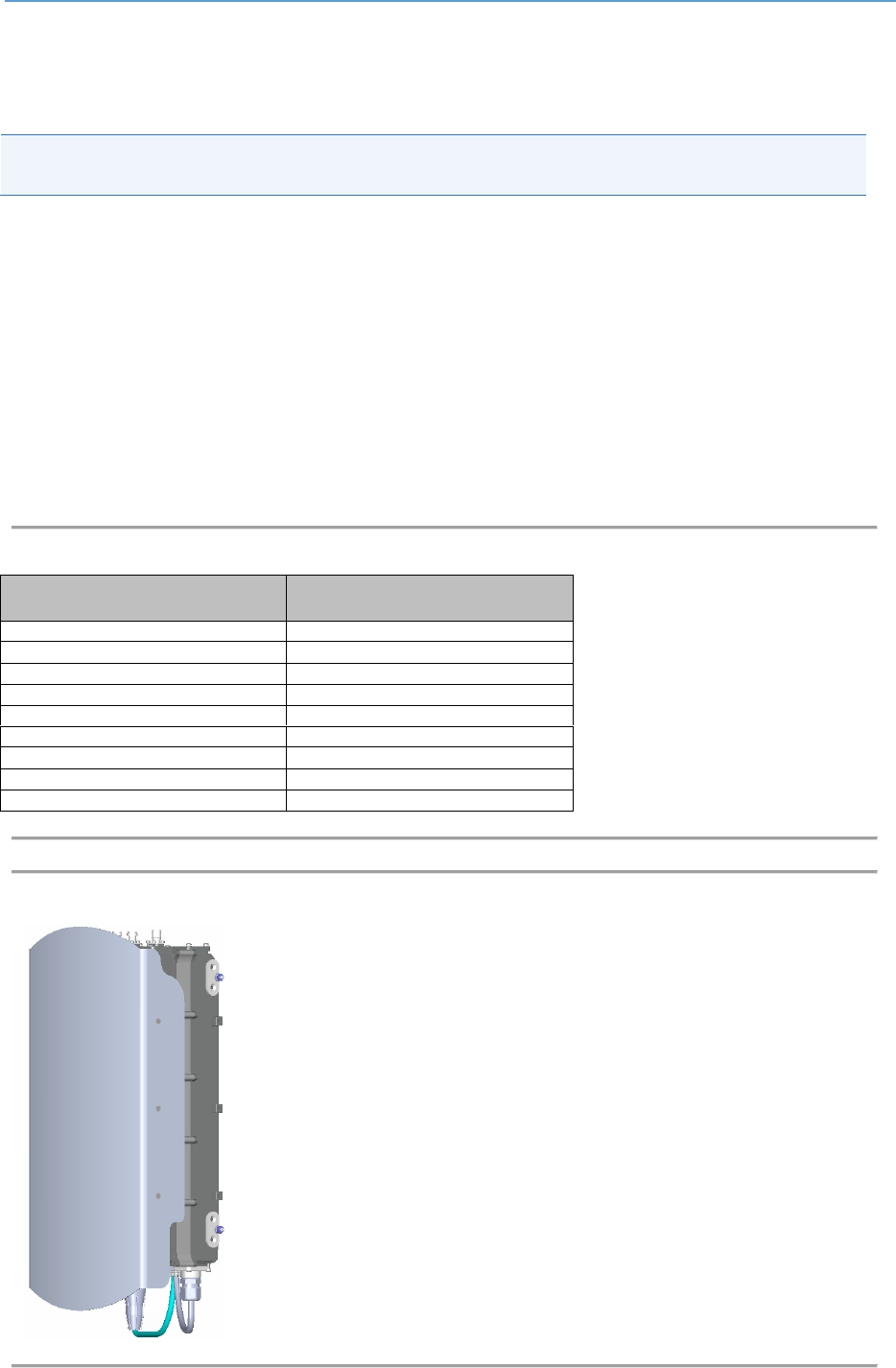
AirHarmony-1000D Installation Guide
UGD-D01083 Airspan Commercial and Internal Use 8
Antenna System
The following antennas are designed specifically for AirHarmony-1000 deployments. Externally
mounted antennas are available for use as well (pending), but are specified separately.
Note: For a list of compatible external antennas, please contact your nearest Airspan sales
representative.
Switched Beam Antenna
The Switched Beam antenna variant includes a steerable antenna mounted on the unit which
provides four direction beams and an omni-directional pattern covering 360 in azimuth. Beam
selection is achieved via a digital control interface. The antenna is a multi-element cross polarized
(dual slant) design which can be used in directional or Omni modes of operation. The GPS antenna is
incorporated in the Switched Beam antenna unit.
Scenario #1 - The Switched Beam antenna is mounted directly on the unit and connected via its two
RF ports and the control port.
Scenario #2 - The Switched Beam antenna is mounted on the pole above the unit connected via its
two RF ports and the control port.
Table 6: Omni Antenna Parameters
Parameter
2.x GHz
Frequency
2.3–2.7
Polarization
Dual Slant ±45
Polarization discrimination
16 dB
Boresight gain
2.0 dBi
Peak gain
7.5 dBi
Azimuth HPBW
Omni-Directional
Elevation HPBW
20
Electrical tilt
N/A
Grounding
DC GND
Figure 1: AirHarmony-1000D with sun-shield

AirHarmony-1000D Installation Guide
UGD-D01083 Airspan Commercial and Internal Use 9
About This Document
Purpose
This guide provides the workflow and step-by-step procedures for Installing the AirHarmony-1000D.
These procedures include:
Verify prerequisites
Install wall / pole mount
Install the AirHarmony-1000D
Connect and manage cables
Intended Audience
This guide is intended for persons who are responsible for installing the AirHarmony-
1000D equipment.
These persons should have a working knowledge of the equipment.
Document Conventions
This document uses the following typographic conventions.
Table 7: Typographic Conventions
Convention
Element
Blue underlined text
Cross-reference links.
Bold text
Keyboard buttons and GUI elements.
Command
Command names or phrases.
Computer output
Text displayed by the computer.
Hyperlinks
Website and e-mail addresses.
Danger
Signifies a hazardous situation—if not avoided—will
cause death or serious injury. Describes how to avoid
it.
Warning
Signifies a hazardous situation—if not avoided—can
cause death or serious personal injury. Describes
how to avoid it.
Caution
Signifies a hazardous situation—if not avoided—can
void the product warranty, and cause property
damage. Describes how to avoid it.
Important
Provides necessary information to explain a task.
Note
Provides additional information.
Tip
Provides helpful hints.
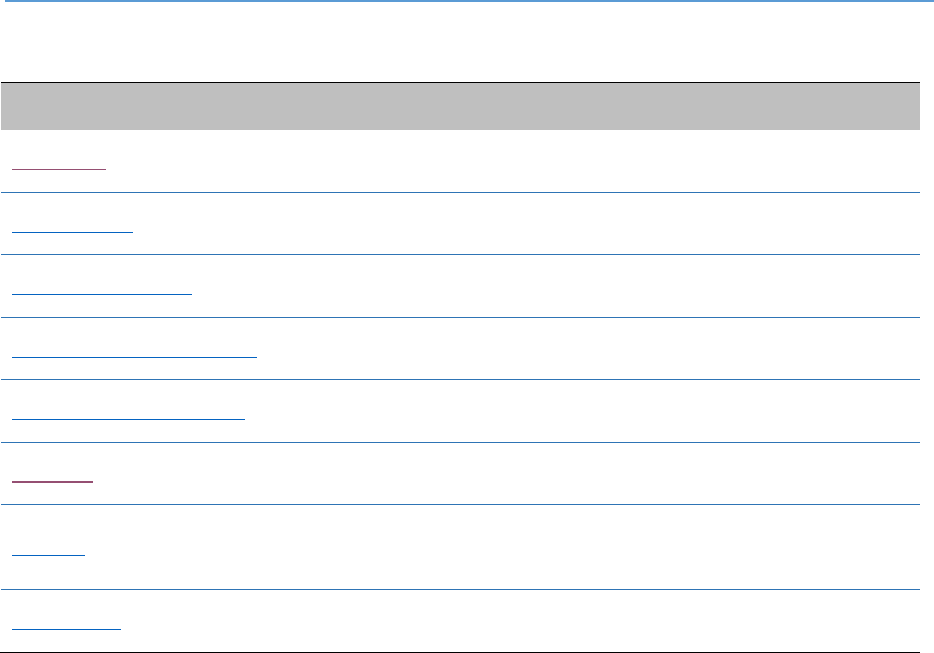
AirHarmony-1000D Installation Guide
UGD-D01083 Airspan Commercial and Internal Use 10
Document Organization
Chapter
Contents
Introduction
Provides a comprehensive overview of AirHarmony 1000 and
its installation.
Getting Started
Provides workflows for installation .
Verifying Prerequisites
Lists the hardware, software, and client requirements for
installation.
AirHarmony-1000D Installation
Describes how to install AirHarmony-1000D.
Connect and Manage Cables
Describes how to connect the cables.
Job Sheet
Provides information that aids users in performing the
installation.
Checklist
Provides an overview of the high–level steps involved in the
workflow.
Abbreviations
Lists the abbreviations used in this document and their
expansions.
Related Reading
The following documents contain related information:
AirHarmony-1000D Hardware Product Specification
AirHarmony-1000D Commissioning Manual

AirHarmony-1000D Installation Guide
UGD-D01083 Airspan Commercial and Internal Use 11
Customer Care Help Desk
Airspan’s Customer Care Help Desk offers prompt and efficient customer support services.
Note: To avail Airspan’s Customer Care Help Desk support, you must be a registered user and
must have a valid support contract. To register, click here and fill the Registration form.
To create and update issue logs, send e-mails to Customer Care Help Desk. Once you submit your
issue, the system generates a new issue and sends an issue number for your reference. The system
uses this issue number to categorize and store e-mails under the appropriate issue.
To help Customer Care Help Desk identify your issue, include the issue number and your Customer
Care Helpdesk account details in all further communications.
Main Operations
Airspan Communications Ltd.
Capital Point
33 Bath Road
Slough, Berkshire
SL1 3UF, United Kingdom
Tel: +44-1895-467-100
Worldwide Headquarters
Airspan Networks Inc.
777, Yamato Road, Suite 105
Boca Raton, FL 3341-4408, USA
Tel: +1 561 893 8670
Airspan Encourages Comments
Airspan welcomes any feedback and suggestions that help to improve the quality of the
documentation. Send your feedback to documentfeedback@airspan.com.

AirHarmony-1000D Installation Guide
UGD-D01083 Airspan Commercial and Internal Use 12
1 Introduction
This section provides a descriptive overview of the Airspan’s AirHarmony-1000D Micro / Pico eNodeB
variant and its place in the Airspan product suite.
1.1 AirHarmony-1000D
AirHarmony-1000D is part of Airspan’s carrier-class 4G Micro eNodeB family. AirHarmony-1000D
supports 3GPP’s Long Term Evolution (LTE) eNodeB specifications, providing high-speed data and
mobility in order to meet the demands of the Broadband Wireless Access market.
AirHarmony-1000D employs Software Defined Radio (SDR) technology, together with two transmit
and receive paths, antennas and a GPS receiver - all in a highly integrated, physically small and light,
All-Outdoor package, targeted to blend seamlessly into the urban environment. This very compact
outdoor product minimizes physical footprint, power consumption and operator OPEX.
AirHarmony-1000D will support a wide array of frequencies and channel sizes, able to operate in both
licensed and unlicensed bands. Frequencies and channel sizes will be added regularly.
AirHarmony-1000D implements dual 37 dBm (2 x 5W) transmitters with the availability of several
optional integral antennas and external antennas connectivity.
AirHarmony-1000D fully supports the standard LTE (Uu/S1/X2) interfaces.
All Airspan eNodeB products, including AirHarmony-1000D, are interoperable with a rich portfolio of
3rd party end user devices, including many handsets, indoor UEs, outdoor UEs and USB dongles from
several ODMs, using various chipsets. For an updated of interoperability list, please contact your
nearest Airspan Sales Representative.
Note: For management please refer to the AirHarmony-1000D LTE Commissioning Manual as well
as the Netspan User Manual.
1.1.1 Deployment
A highly flexible and scalable 4G Base Station, the AirHarmony-1000D is capable of supporting LTE
profiles across multiple frequency bands.
Note: The following is for illustration only; actual layout may differ as infrastructure is installation-
specific.
Note: AirHarmony-1000D must be properly grounded according with NEC and other local safety
code requirements.
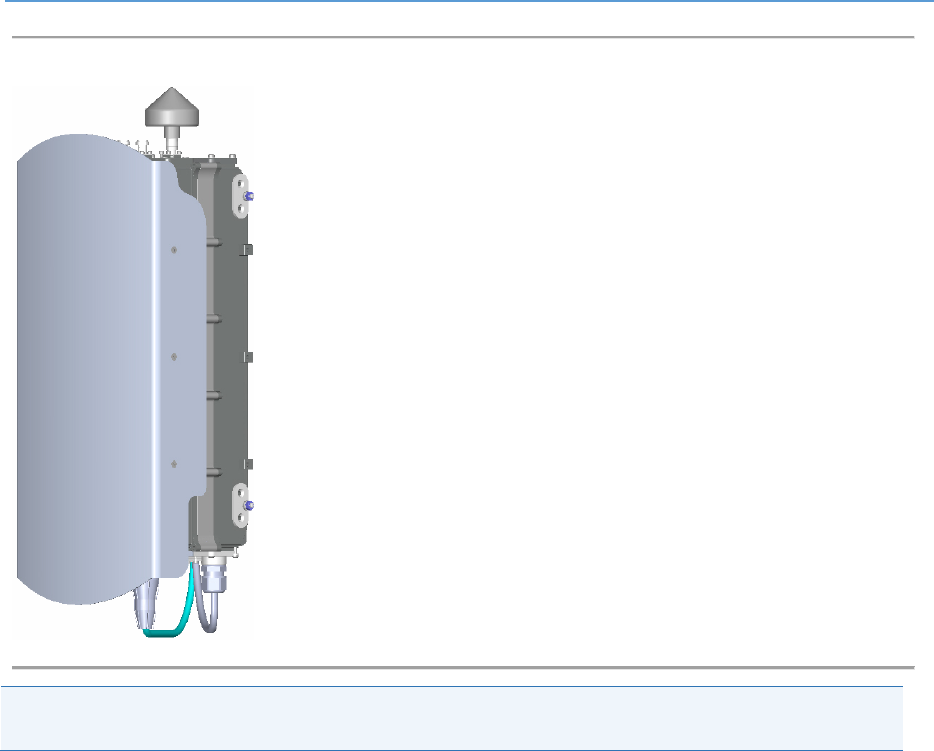
AirHarmony-1000D Installation Guide
UGD-D01083 Airspan Commercial and Internal Use 13
Figure 2: AirHarmony-1000D
Note: The illustration above displays the GPS connected directly to the top of the unit; there is also
a remote GPS antenna option.
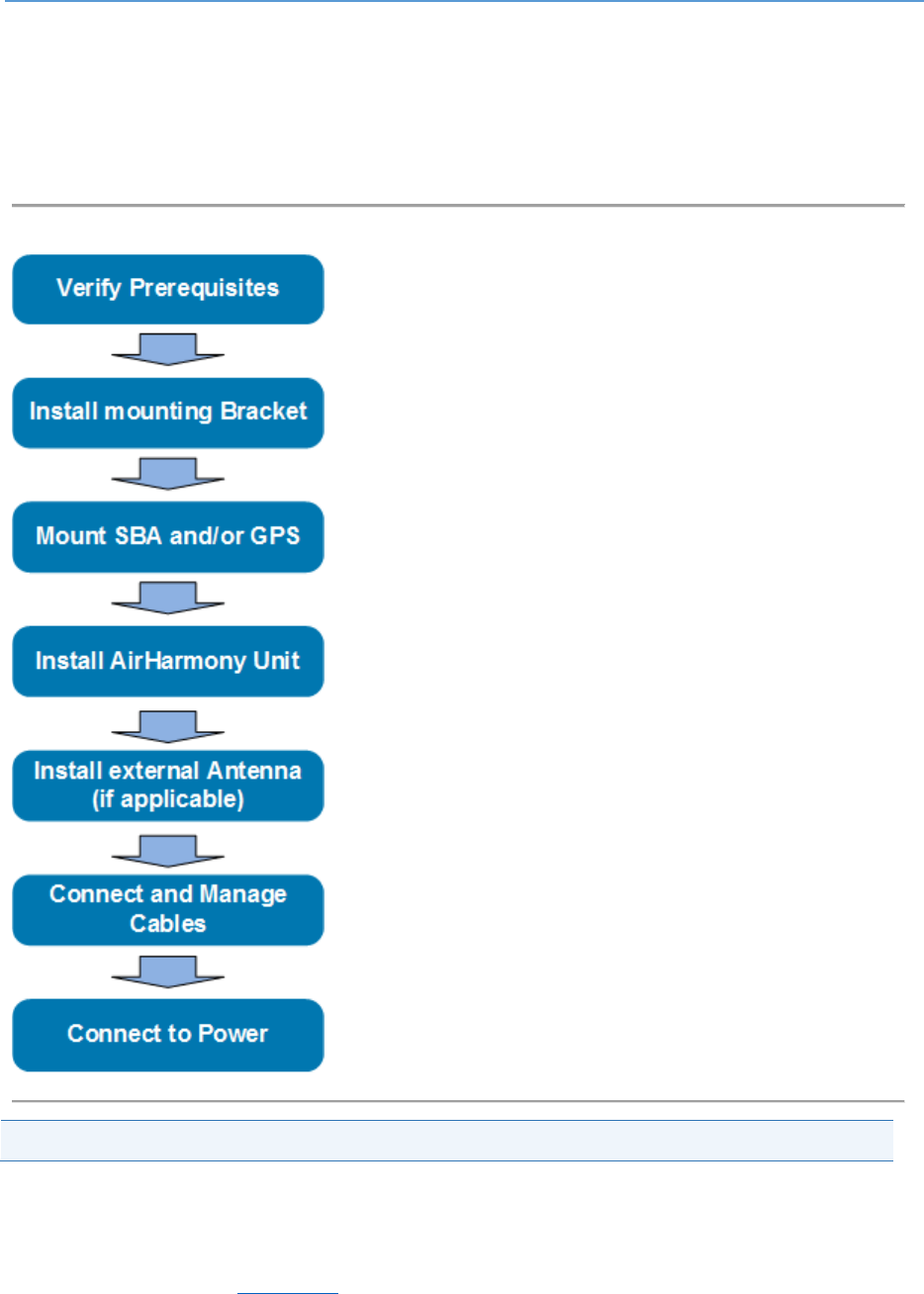
AirHarmony-1000D Installation Guide
UGD-D01083 Airspan Commercial and Internal Use 14
2 Getting Started
2.1 Workflow of Installation
The Workflow to install the AirHarmony-1000D is shown in the following diagram:
Figure 3: Workflow
Caution: Antennas must be connected and attached before AirHarmony-1000D is powered on.
2.2 AirHarmony-1000D Installation Checklist
Plan the installation of the AirHarmony-1000D by using the Installation Checklist, which you can find
as a removable job aid in Appendix A for this guide.
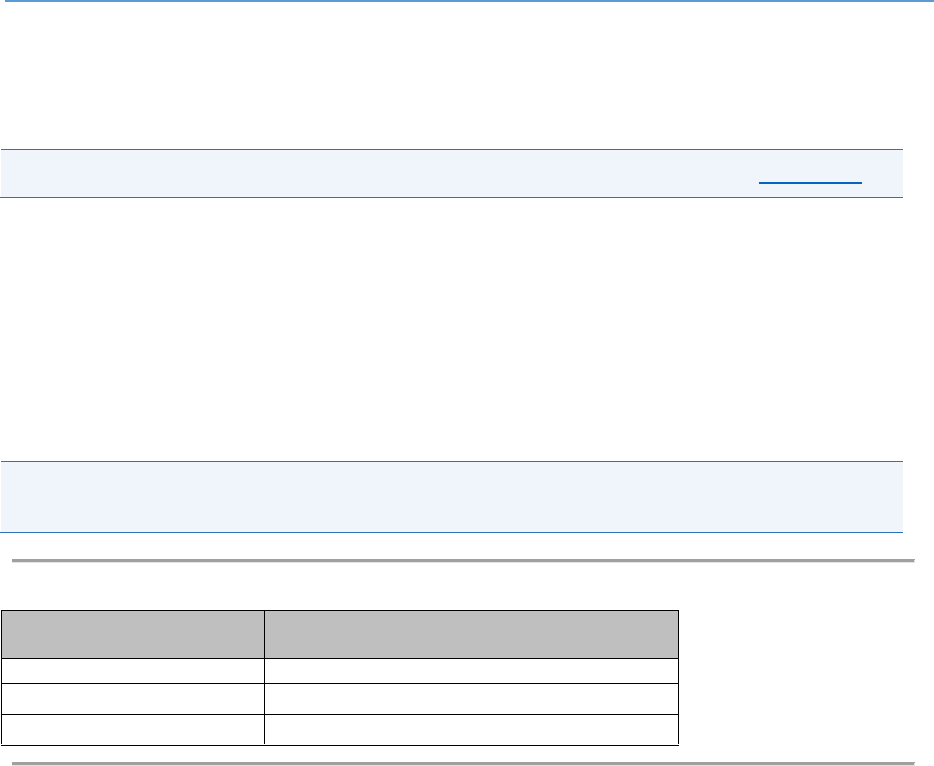
AirHarmony-1000D Installation Guide
UGD-D01083 Airspan Commercial and Internal Use 15
3 Verifying Prerequisites
Prior to installing the AirHarmony-1000D, verify the required safety, power, tools, parts and
components. This chapter includes the hardware, software, and client requirements for installation.
Important: Set up requirements for the installation is detailed in the Job Sheet, see Appendix A.
3.1 Verifying Site Requirements
To set up the AirHarmony-1000D, an IP connection to a Netspan server is required.
3.2 Verify Installation Requirements
3.2.1 Verify the Tools
Note: AirHarmony-1000D variants with front mounted, Sunshield (pending) and Switched Beam
(pending) antennas come pre-assembled from the production line.
Table 8. Minimum Hardware Requirements
Tool
Use
Large flat bladed screwdriver
securing the pole straps
10mm or 13/32 inch wrench
for securing flange nuts
Large pliers
Tightening cable glands - To fit 15mm
3.2.2 Power Supply
AirHarmony-1000D supports direct connection to DC power source (-48V DC):
Operational Voltage Range: -40.5 to -57 VDC
Transient Voltage: +150V (ETR283)
AC power feed is also available, using an AC/DC power converter offered by Airspan.
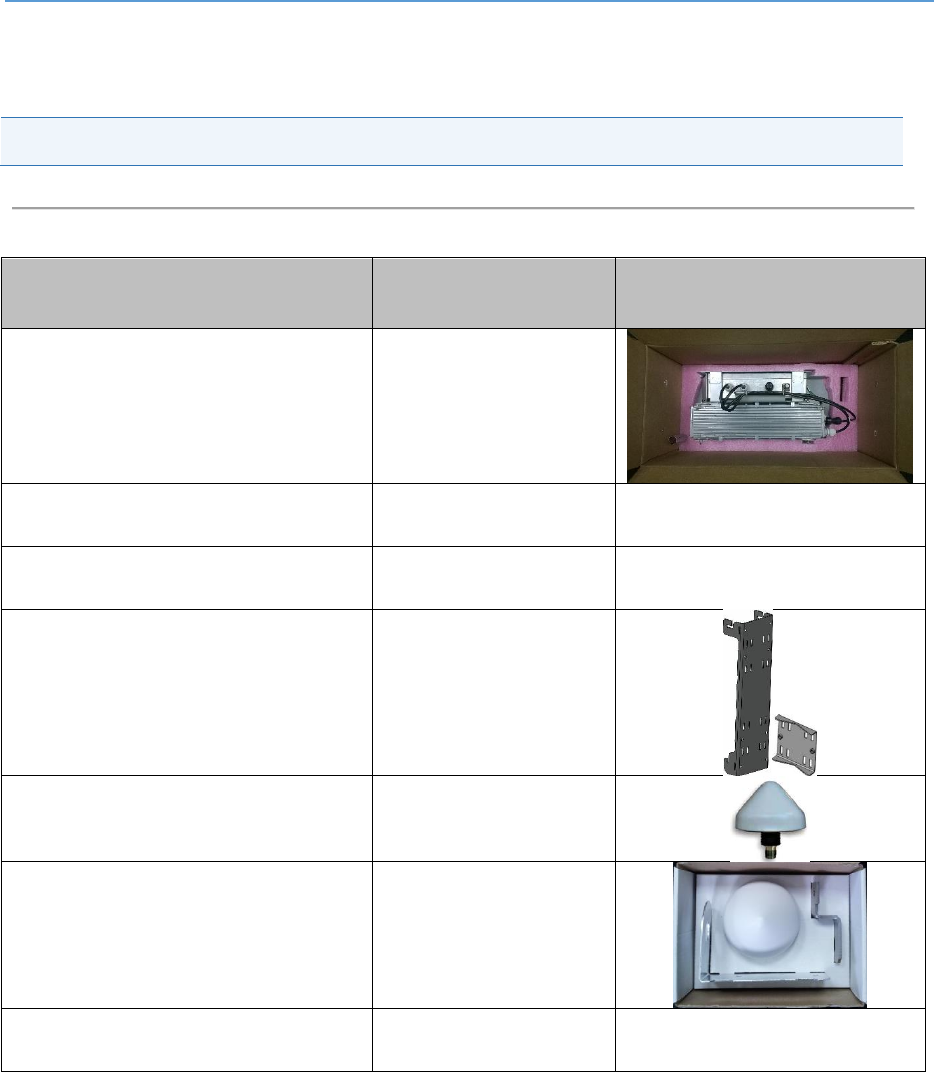
AirHarmony-1000D Installation Guide
UGD-D01083 Airspan Commercial and Internal Use 16
3.2.3 Verify the Parts and Kits
The following figures display various AirHarmony-1000D components and accessory kits.
Note: Verify order and requirements to ensure the correct unit type is being installed.
Table 9: AirHarmony-1000D Components
Parts Description Installation Kit /
Part
Product Code
Images
AirHarmony 1000D 2.496 - 2.568 GHz
(B41L), Connectorized, AC, Copper BH
with PoE out
HAR10D-CN-U41L-B00AP
AirHarmony 1000D 2.618 - 2.69 GHz
(B41H), Connectorized, AC, Copper BH
with PoE out
HAR10D-CN-U41H-B00AP
AirHarmony 1000D 2.496 - 2.69 GHz (B38,
B41), Connectorized, AC, Copper BH with
PoE out
HAR10D-CN-U41-B00AP
AirHarmony 1000D universal wall and
pole mounting kit
HAR10D-U-PMK-2
GPS Antenna with built-in high, interference
rejection
GPS-ANT-3
AirHarmony GPS Kit (including antenna,
bracket, 16m cable and surge protection
kit)
GPS-HAR-KIT-1
2.3-2.7GHz Omni-Directional Switched
Beam 2-8dBi Dual X-Polar Antenna with
GPS
SBA-2.X-GPS-1
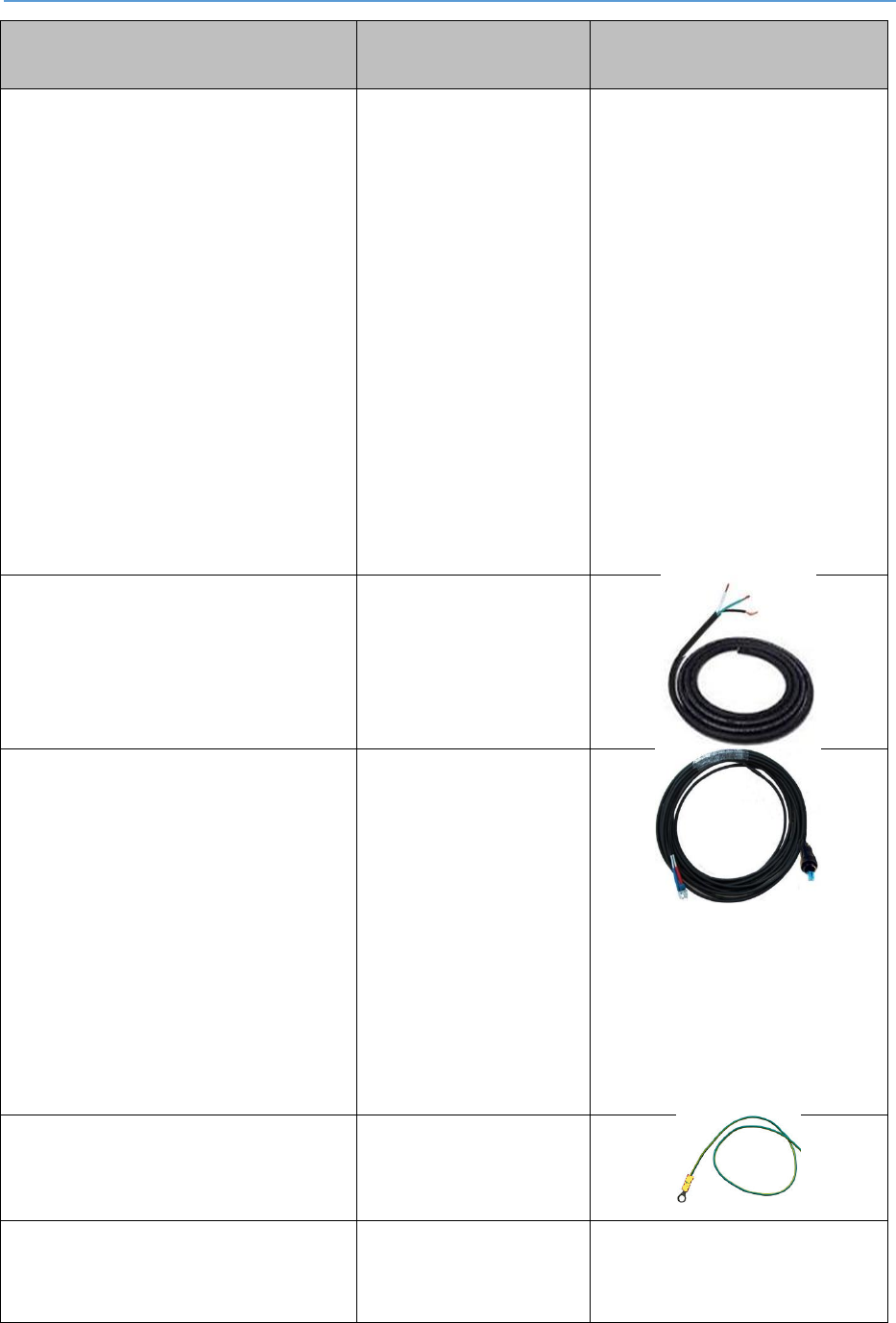
AirHarmony-1000D Installation Guide
UGD-D01083 Airspan Commercial and Internal Use 17
Parts Description Installation Kit /
Part
Product Code
Images
AC/DC Outdoor Power Converter Kit &
hardware
Wall & Pole mounting for AC/DC
Converter
Mounting bracket for AC/DC converter.
Serratub Maxi Clamp, band 12mm
wide + quick adjust lock, 50-215mm
pole dia.
Sems Pan Hd M4x10 DIN 7985 with
Plain&Spring Washers, St St, A2
AC/DC Converter 48V, 240W, 90-
305Vac, IP67, -30/+70C, EN60950-1
SYN-PSU-ODUL-AC-2
DC side cable is pre-connected to the
AirHarmony-1000D DC plug. Cable
length is 300/1000mm
AC side cable 3 wires (brown, blue &
green). Cable length 300mm. should
be connected to the AC cable by using
the weather-proof cable joiner.
AC cable weather-proof cable joiner -
SYN-PWR-JOIN-1
HAR10-ACDC-KIT-ODUL-1
AC Cable, 3x 18AWG per meter, (white,
black & green)
CBL-AC-3x18AWG-1
Outer Fiber Cables (ASX Optical cables in
8 available lengths)
FIB-FA-10-LC-SM-1
10M
FIB-FA-15-LC-SM-1
15M
FIB-FA-30-LC-SM-1
30M
FIB-FA-50-LC-SM-1
50M
FIB-FA-75-LC-SM-1
75M
FIB-FA-100-LC-SM-1
100M
FIB-FA-150-LC-SM-1
150M
FIB-FA-200-LC-SM-1
200M
Ground cable
(Note that the cable is ordered per meter
and the lug is ordered separately. Crimping
is done by the user)
CBL-GND-1M-1
Grounding Lug
Ring Terminal for 6AWG grounding
cable. (M6 x 8mm screw)
CON-LUG-GND-1
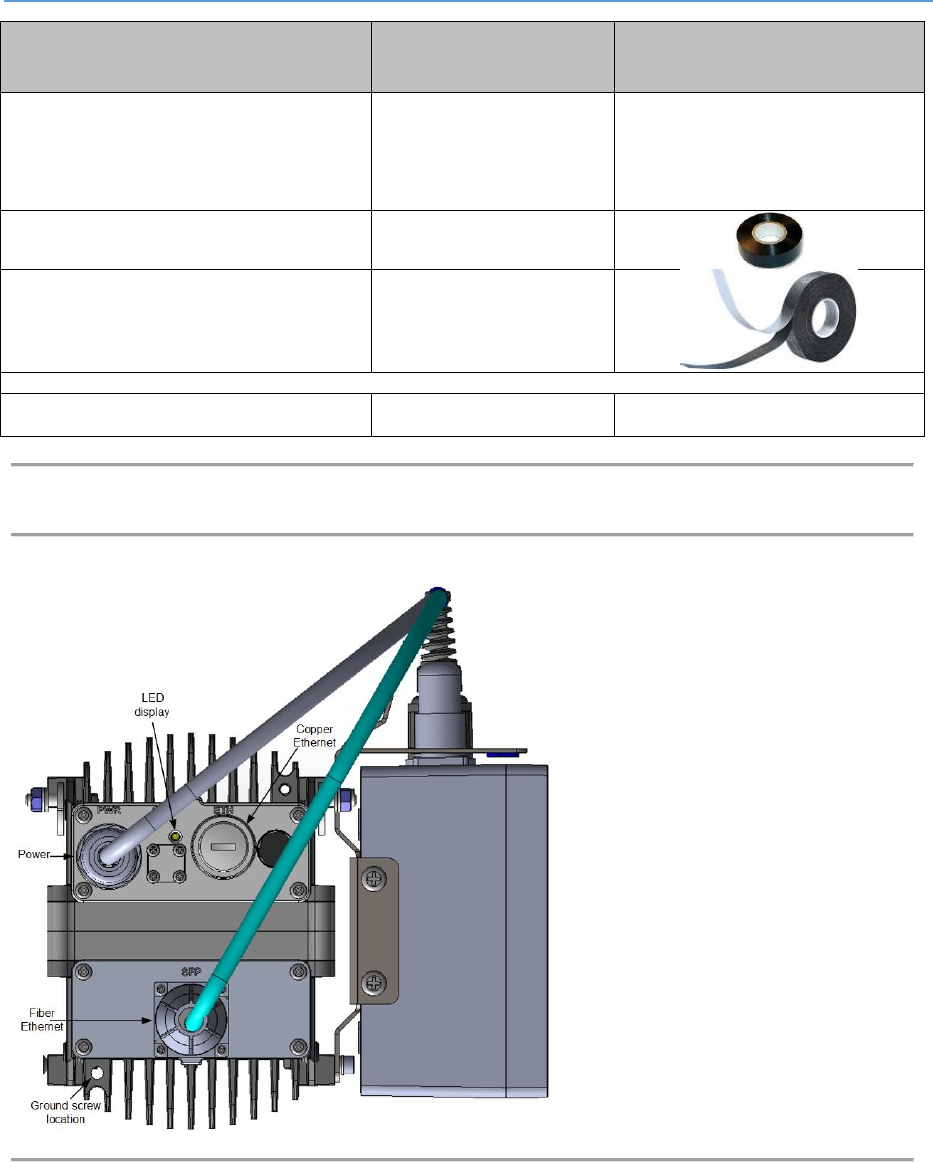
AirHarmony-1000D Installation Guide
UGD-D01083 Airspan Commercial and Internal Use 18
Parts Description Installation Kit /
Part
Product Code
Images
DC Power cable v1, 10m
Alternative to the AC/DC converter kit.
Additional lengths available.
PWR-10-MF-1
PVC Insulation tape
20m, Black 19mm width
PVC-INS-TAPE-1
Self-amalgamating waterproof tape
10m, Black 25mm width
S-AMAL-WP-TAPE-1
Airspan Recommends:
Finisar SFP Transceiver
FTLF1318P3BTL
1000BASE-LX
Tested and approved by Airspan.
Available from Airspan if required.
AirHarmony-1000D is shown below from the Ethernet termination and RF port end views respectively.
Figure 4: AirHarmony-1000D Unit, bottom w/o Sun-Shield
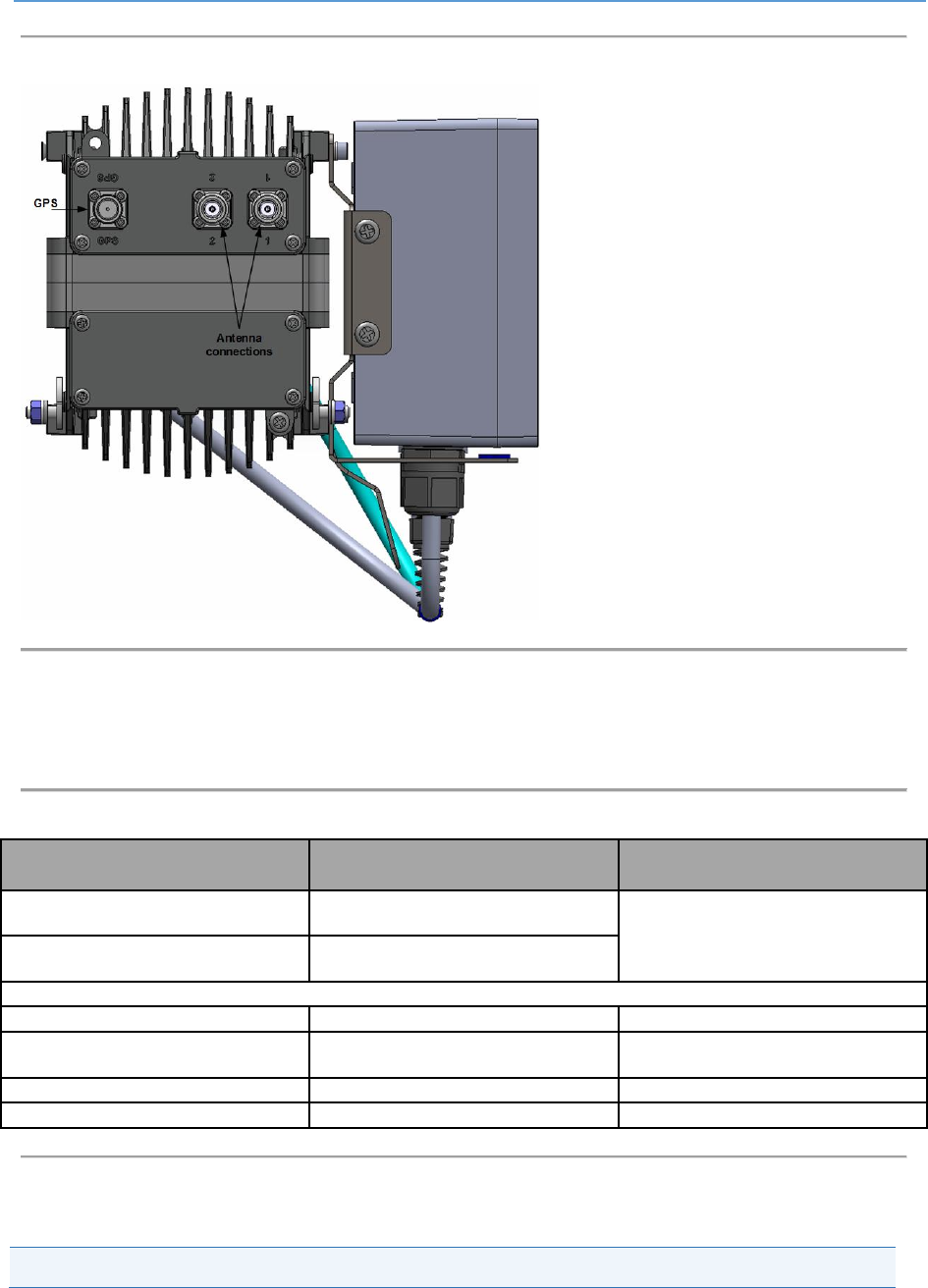
AirHarmony-1000D Installation Guide
UGD-D01083 Airspan Commercial and Internal Use 19
Figure 5: AirHarmony-1000D Unit, Top, RF ports w/o Sun-Shield
3.2.4 Physical Dimensions
AirHarmony-1000D is in an all outdoor enclosure.
Table 10. AirHarmony-1000D Physical Dimensions
Variant
Dimensions (H x W x D)
Comment
Connectorized
(with sunshield)
549 x 142 x 203 mm / 21.6 x 5.6 x
8.0 in.
The physical dimensions exclude
connectors
SBA (with sunshield)
770 x 142 x 203 mm / 30.3 x 5.6 x
8.0 in.
Weight
Main unit (Connectorized)
11 kg (24.25 lb)
Universal mounting bracket
(Including pole straps)
925 g (2.04 lb)
Sun-shield
575 g (1.27 lb)
SBA Antenna
1 Kg (2.20 lb) (pending)
3.2.5 Environmental
Note: AirHarmony-1000D is not meant to be used in a Marine environment.
AirHarmony 1000 meets the following environmental requirements:
ETSI EN 300-019-1-4 Operational (non-weather protected equipment)
ETSI EN 300-019-1-1 Storage (weather protected, not temperature controlled locations)

AirHarmony-1000D Installation Guide
UGD-D01083 Airspan Commercial and Internal Use 20
ETSI EN 300-019-1-2 Transportation
Table 11. AirHarmony 1000 Environment Compliance
Type
Details
Standard Compliance
Operating temperature
-40°C to 55°C
ETSI 300 019 1-4
Operating humidity
5% - 100% non-condensing
ETSI 300 019 1-4
Storage temperature
-40°C to 70°C
N/A
Storage humidity
5% - 100% non-condensing
ETSI 300 019 1-4
Rain and dust ingress
protection
IP66
N/A
Operational altitude
70-106 kPa as well as:
From -60m to 1800m @ 40C
From 1800m to 4000m @ 30C
ETSI 300 019 1-4
Solar radiation
1120 W/m2
ETSI 300 019 1-4
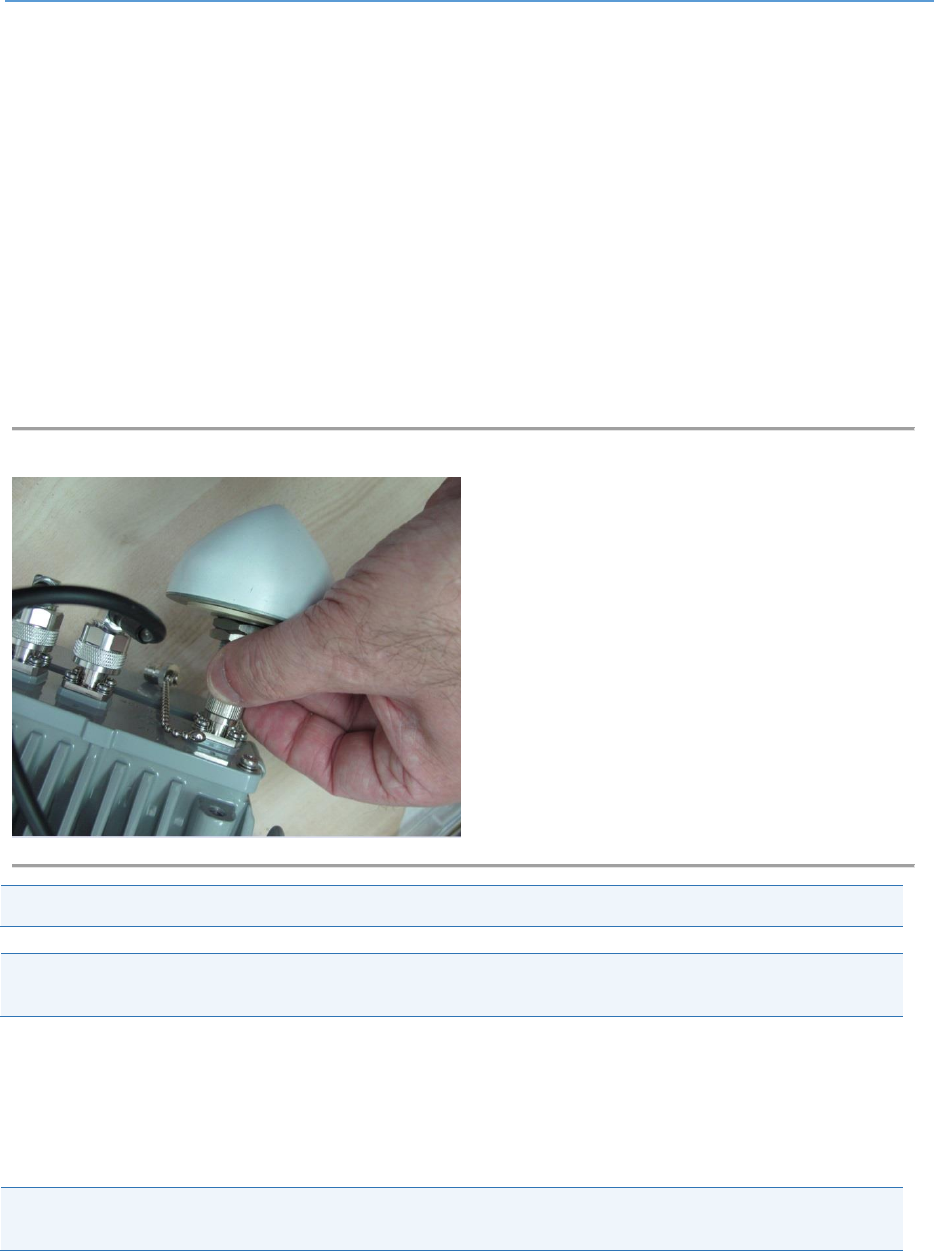
AirHarmony-1000D Installation Guide
UGD-D01083 Airspan Commercial and Internal Use 21
4 Before Installation of AirHarmony-1000D
Prior to installation of the AirHarmony either on a pole or a wall the GPS antenna should be
connected and the all antenna connections should be weather-proofed.
4.1 Connection of GPS Antenna
The following defines the connection of the GPS antenna which is installed directly to the top of the
unit.
1. Remove the protective dust cap from the GPS antenna jack prior to mounting on the
AirHarmony-1000D.
2. Align the GPS jack with the plug attached to the top panel on the AirHarmony-1000D.
3. Attach the GPS antenna to the TNC connector on the unit.
Figure 6: Attaching GPS antenna to unit
Caution: Take care not to over tighten so as not to damage the threads.
Note: It is good practice to weather-proof the antenna connections both the GPS connection and
the RF connections.
4.2 Weather-proofing of the Antenna Connections
Weather-proofing of all the connections is required. This is done with a layer of self-amalgamating
tape followed by an over layer of PVC tape. The weather-proofing is best done at this stage to give
easier access to the connections.
Note: It is good practice to weather-proof the antenna connections both the GPS connection and
the RF connections.
The RF connectors on the Front Mount Antenna variant arrive pre-connected. Weather-proofing is
best done at this stage to give easier access to the connections.
1. Verify a secure connection of the RF cable between the antenna and the appropriate RF
connection on the top of the unit.
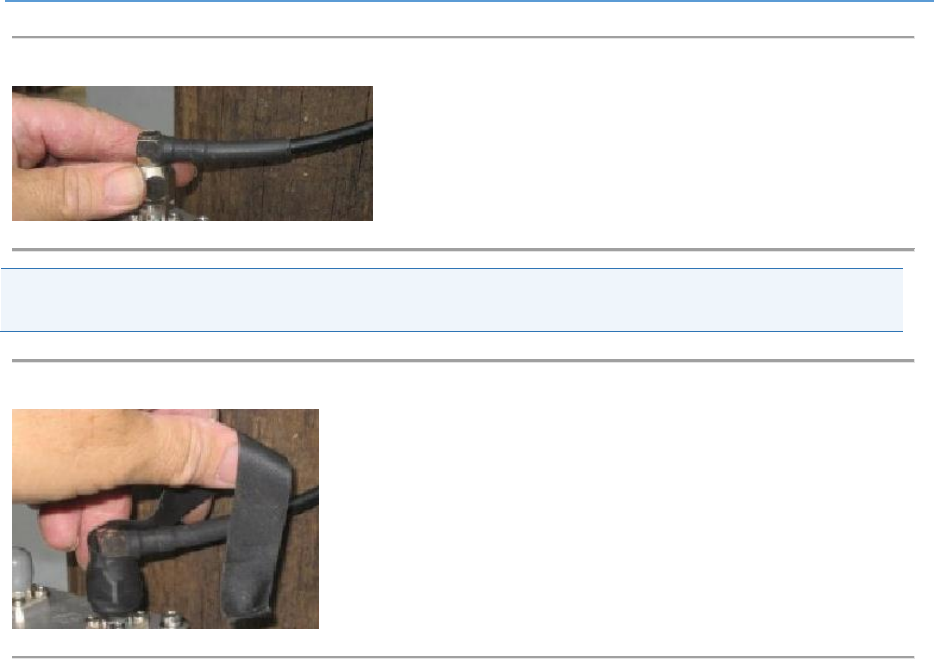
AirHarmony-1000D Installation Guide
UGD-D01083 Airspan Commercial and Internal Use 22
Figure 7: Verify connection of RF cable
Caution: Do not over-tighten the RF connector. RF failures can result when the RF connector is
over-tightened.
Figure 8: Weather-proof the connection
2. Weather-proofing of the connections is mandatory. This is done with a layer of self-
amalgamating tape followed by an over layer of PVC tape. Both the self-amalgamating tape
and the PVC tape are available from Airspan.
3. Verify the RF connector is completely weather-proof.
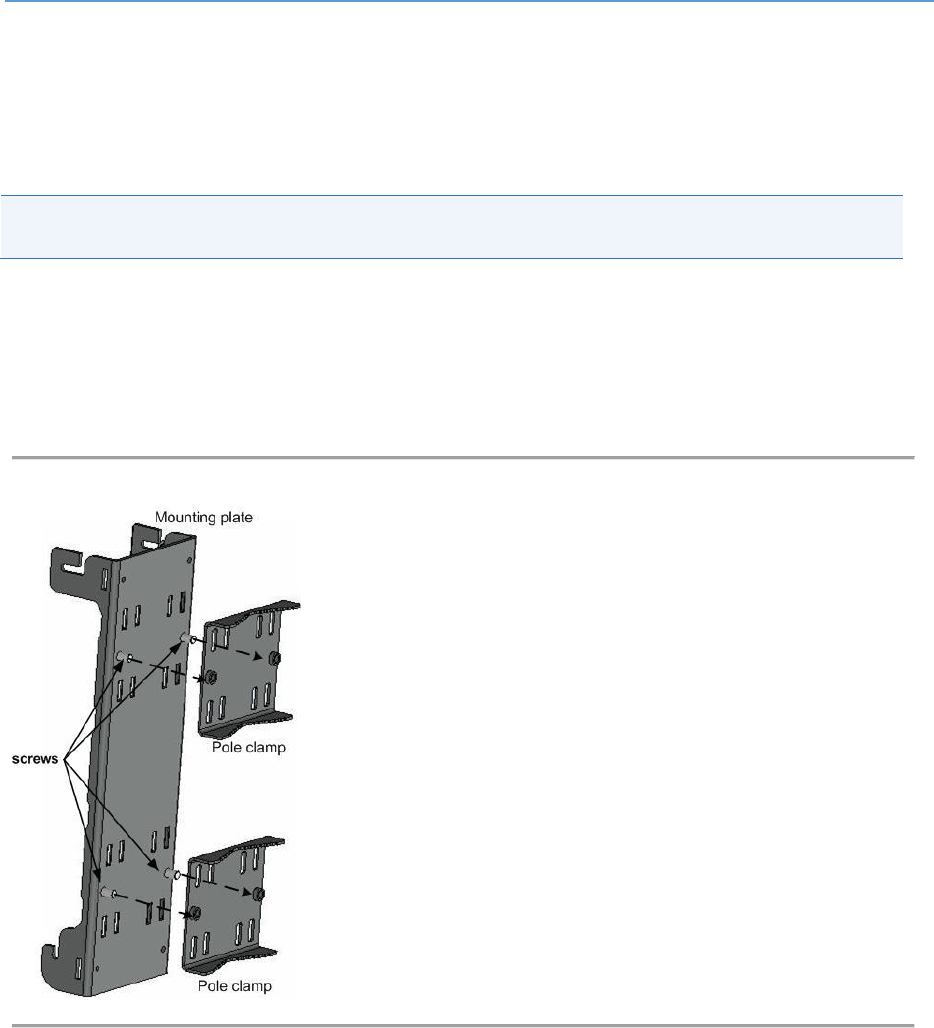
AirHarmony-1000D Installation Guide
UGD-D01083 Airspan Commercial and Internal Use 23
5 Installing AirHarmony-1000D
Install the AirHarmony-1000D eNodeB by pole mount or wall mount. AirHarmony-1000D is mounted
on a pole or wall with its pre-installed antenna (front mount or SBA variants (pending)) or in close
proximity to its external antenna (connectorized variant). Take care to install the mounting plate the
correct way up. This is with the slot openings in the bracket at the top edges as shown below.
Caution: Proper local rigging and hoisting practices should be followed when installing the
AirHarmony-1000D.
5.1 Pole Mount Assembly
The following images show the pole mount assembly.
1. Prepare the mounting plate by assembling the pole clamps in the provided threaded holes
with the provided M8X20 Hex Cap screws.
Figure 9: Pole mounting assembly preparation
2. Insert the clamp straps through the slots in the mounting plate passing them through the pole
clamps.
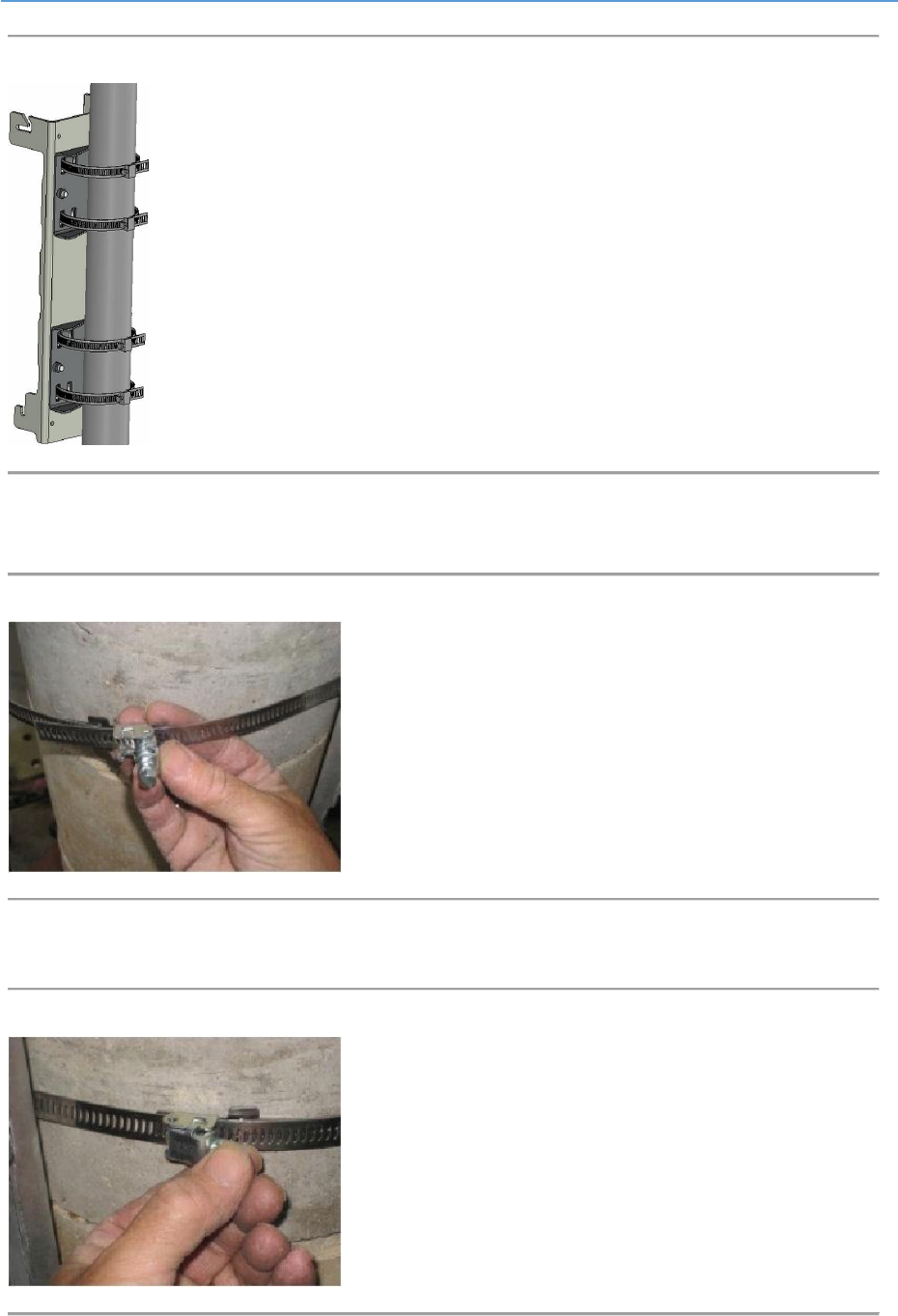
AirHarmony-1000D Installation Guide
UGD-D01083 Airspan Commercial and Internal Use 24
Figure 10: Mounting plate on pole
3. Position mounting plate on the pole with slots facing up.
4. Feed clamp bands through the quick release locking mechanisms and wrap around pole.
Figure 11: Assemble clamp bands (4 required)
5. Wrap the band to properly fit on the pole. Press down locking mechanism with band excess
fed through the mechanism.
Figure 12: Press down locking mechanism
6. Align and position each of the 4 pole clamps. Tighten the clamp bands with large flat
screwdriver in place.
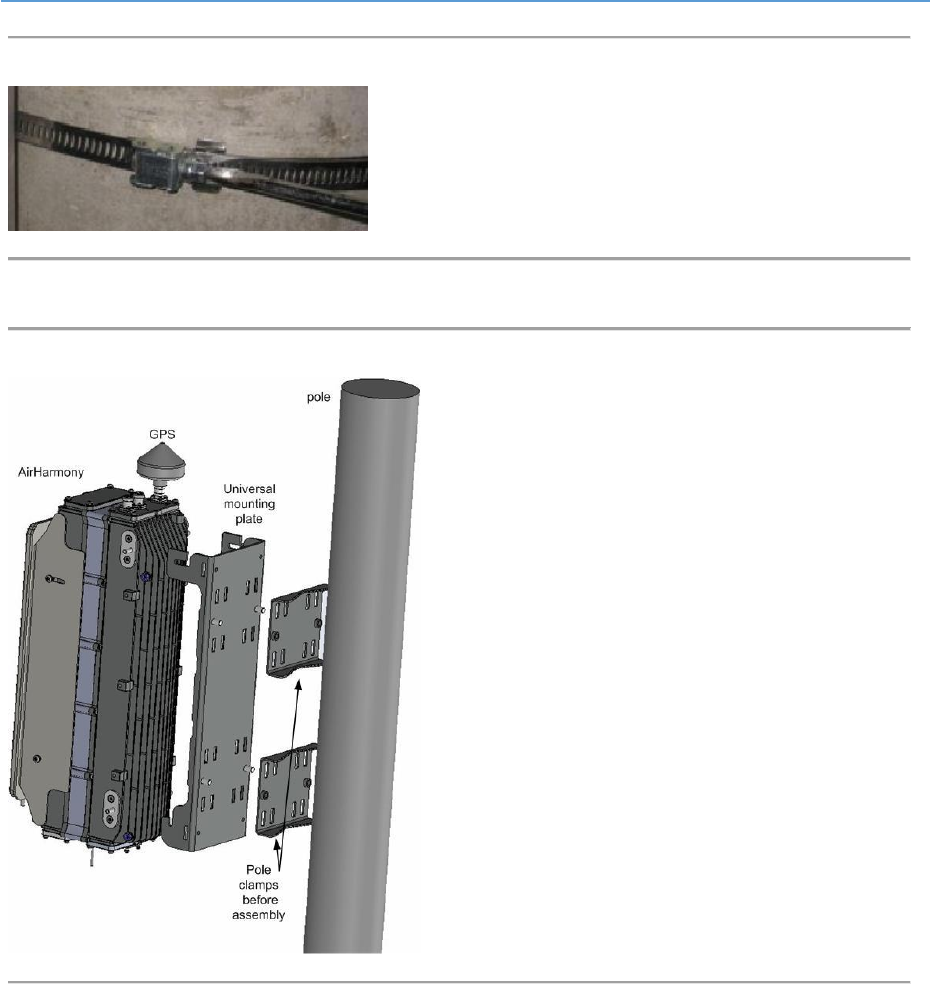
AirHarmony-1000D Installation Guide
UGD-D01083 Airspan Commercial and Internal Use 25
Figure 13: Tighten clamp bands
7. Mounting plate is installed and ready for AirHarmony-1000D mounting.
Figure 14: Pole mounting – exploded view
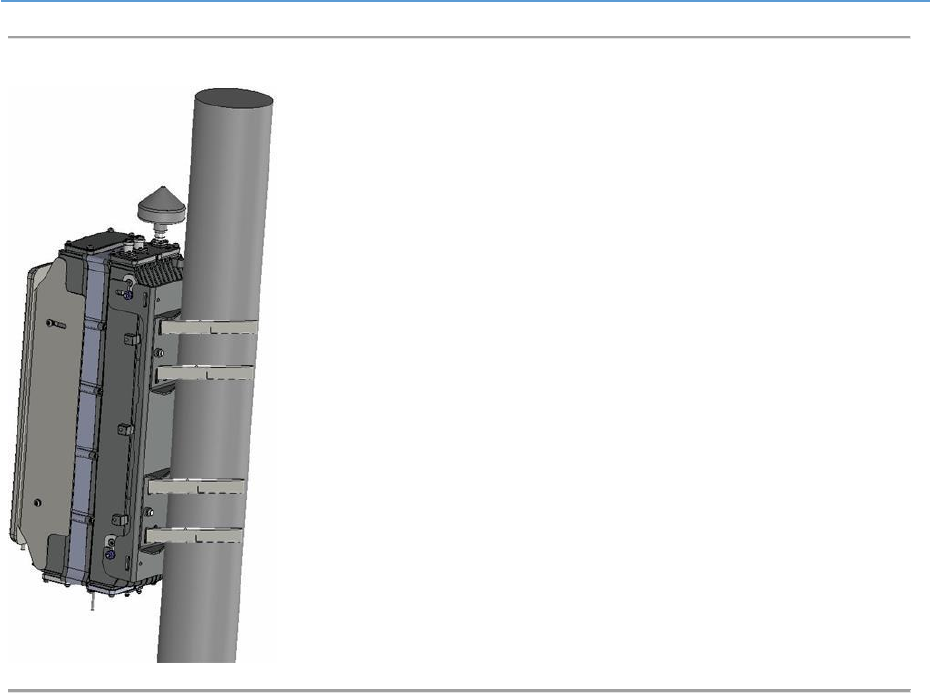
AirHarmony-1000D Installation Guide
UGD-D01083 Airspan Commercial and Internal Use 26
Figure 15: Mounted on pole
5.2 Wall Mount Assembly
The following images show the wall mount assembly.
1. Position mounting plate against the wall with slots facing up. Be sure to position the wall
mounting plate straight with level mounting to ensure the unit sits evenly.
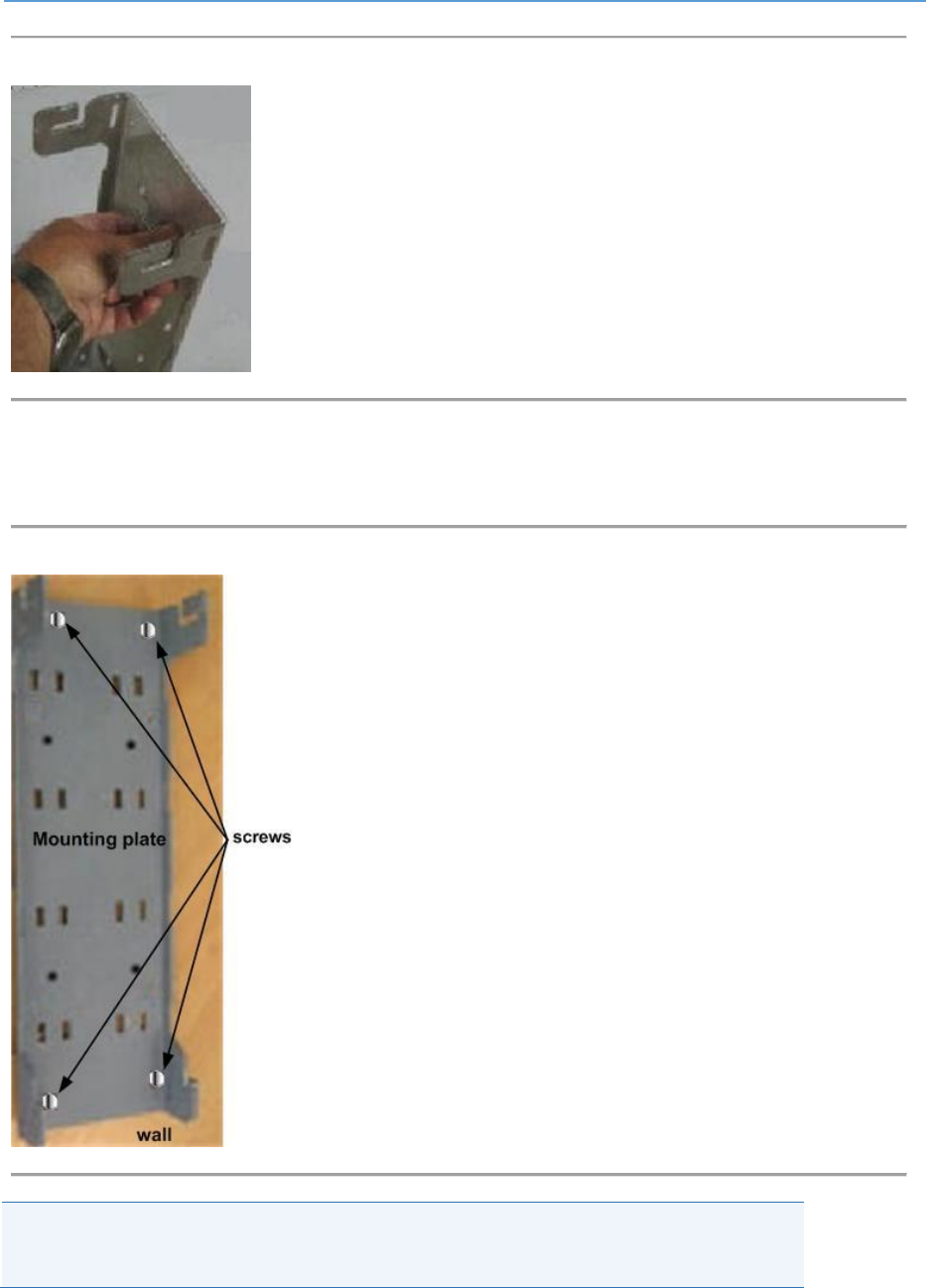
AirHarmony-1000D Installation Guide
UGD-D01083 Airspan Commercial and Internal Use 27
Figure 16: Positioning wall mounting plate
2. Mark the wall through the holes on the wall mount at the required height.
3. Attach the mounting plate to the wall using wall plugs (x4) rated for at least 8-10 Kg per
fastener.
Figure 17: Wall mounting plate fastened on wall
Note: Wall plugs (x4) and necessary hardware are not supplied by Airspan and are the
responsibility of the installer. Recommended minimum 8mm dia. with appropriate wall
plugs according to field conditions.
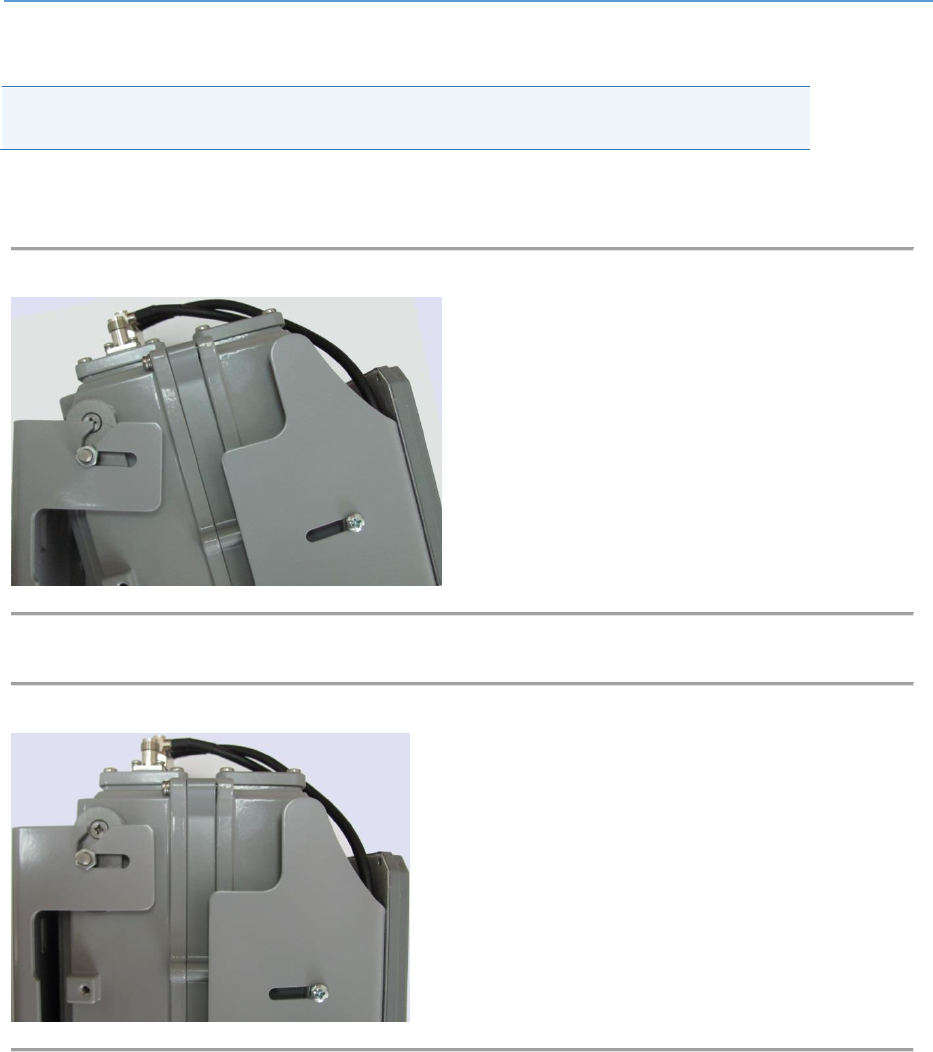
AirHarmony-1000D Installation Guide
UGD-D01083 Airspan Commercial and Internal Use 28
5.3 Securing AirHarmony-1000D to the Mounting Plate
Note: The following procedure shown with the Front-Mount antenna variant as shown
below.
To mount AirHarmony-1000D to the mounting plate, perform the following:
1. Loosely fit the flange nuts on the studs protruding from the sides of the unit.
Figure 18: Lift unit to top of mounting plate
2. Hook the studs into the top slots of the mounting plate.
Figure 19: unit engages into slots on the top of mounting plate
3. With the studs engaged in the top slots raise the unit slightly until the bottom studs also drop
into their respective slots.
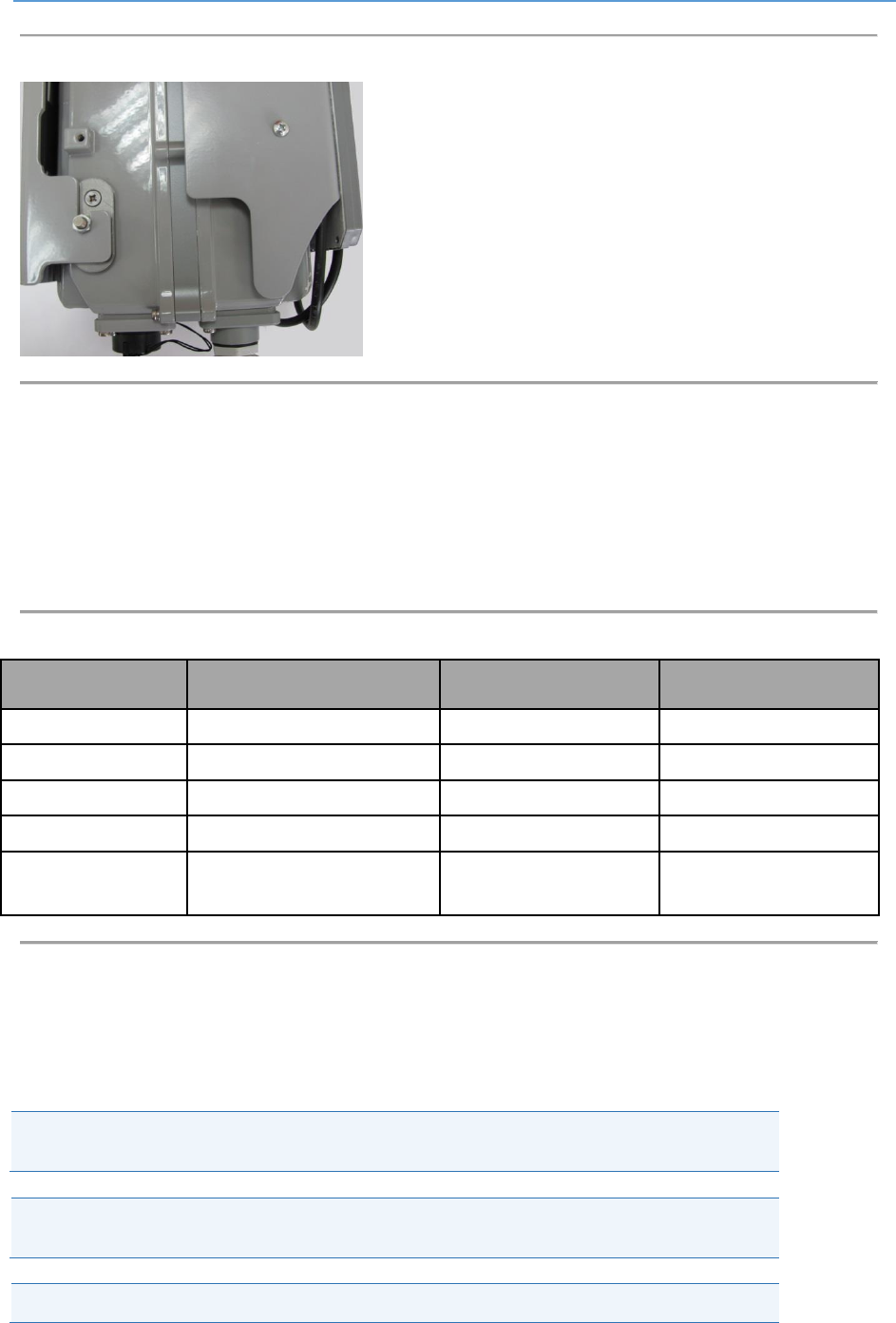
AirHarmony-1000D Installation Guide
UGD-D01083 Airspan Commercial and Internal Use 29
Figure 20: AirHarmony-1000D unit engaged into the bottom slots
4. Tighten the flange nuts (4 places) to the required degree of down-tilt.
5. Check and tighten all flange nuts.
5.4 LED Display
A single tri-color LED (Green/Red/Orange) appears at the bottom of the unit, providing unit status
indication. When powering up refer to the following table for indication of current status:
Table 12: LED display
Name
Color
Status
Description
Powering Up
Orange
On Continuously
Till the SW starts loading
Software loading
Green
Blinking (3Hz)
While SW is loading
Normal Operation
Green
On Continuously
Normal operation (no alarm)
Major Alarm
Red
Blinking (3Hz)
Service not affected
Critical Alarm
or
Sector OOS
Red
On Continuously
5.5 Connecting the Ground Cable
Connect the ground cable after attaching the grounding lug (optionally supplied by Airspan – CBL-
GND-1M-1 and CON-LUG-GND-1) to the M6 threaded connection on the bottom of the main body
casting.
Note: Cutting the Ground cable to the required length and crimping the grounding lug is
performed by the Installer.
Note: The ground cable is available per meter. The lug can also be used for securing the
ground cable to the other side.
Note: The ground surface is bare metal and needs no preparation.
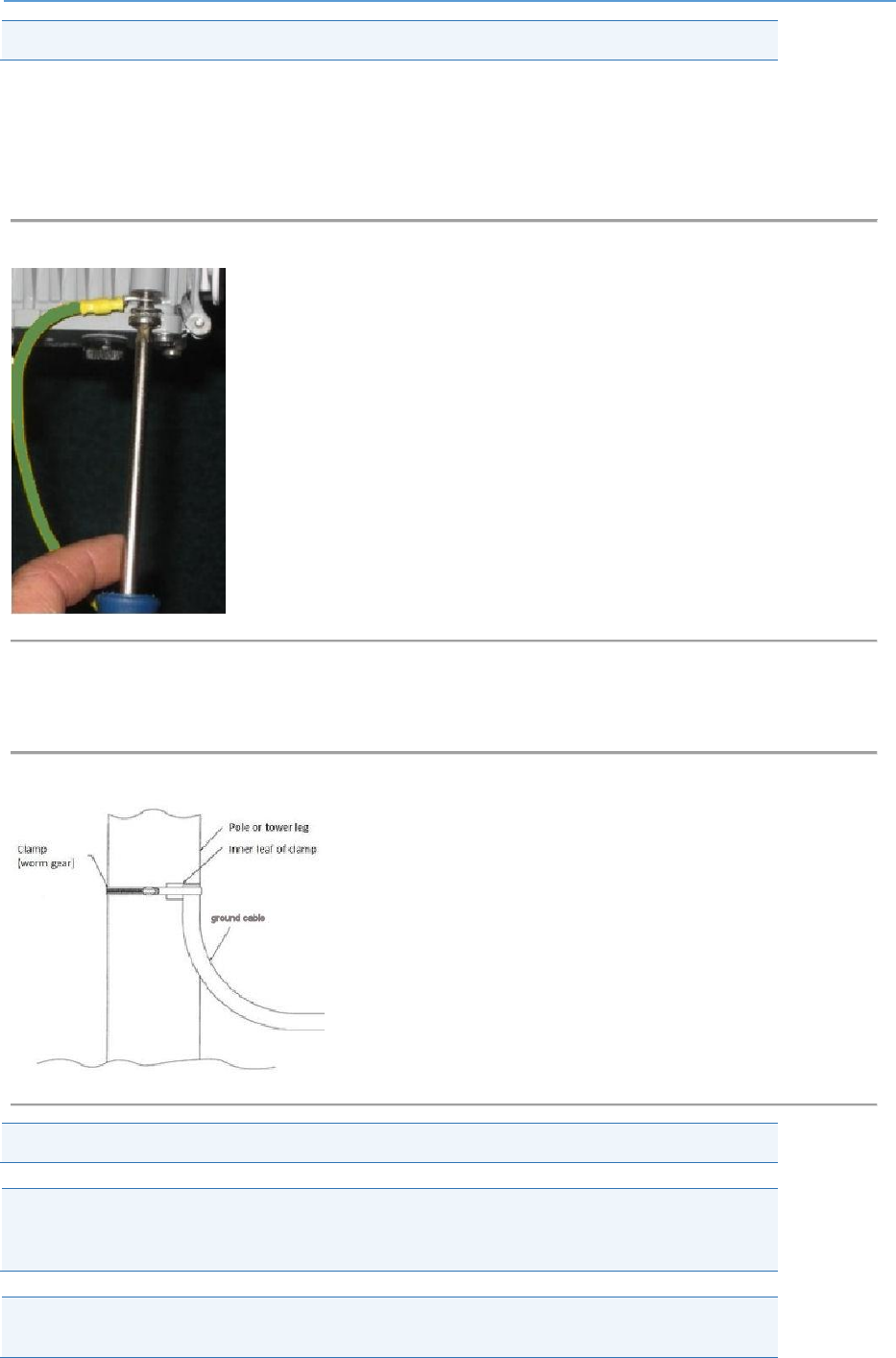
AirHarmony-1000D Installation Guide
UGD-D01083 Airspan Commercial and Internal Use 30
Note: Prior to insertion apply No-Ox or other approved anti-oxidation agent.
This ground cable should be connected to a protection ground bar or clamped directly to a steel
structure. A direct earth ground connection is required for the surge protection devices inside the
AirHarmony-1000D to be effective.
1. Remove grounding screw and slip the ring terminal end of the ground cable onto the screw
prior to re-setting into the threaded hole.
Figure 21: Attaching ground cable to AirHarmony-1000D
2. Connect the ground cable to the protection ground bar using suitable crimp lugs.
Alternatively use a clamp to bond the ground cable to the mounting pole or to the tower
structure.
Figure 22: attach ground cable to pole (example)
Note: Above drawing is for illustration only – use locally approved method for grounding.
Note: For wood pole installations, a 5/8" x 8' ground rod should be installed immediately
adjacent to the wood pole and the #6 AWG stranded conductor extended down to the
ground rod and connected using and approved method (Exothermic or split bolt).
Note: When installing a protection ground take care to use suitable metal combinations
to avoid or minimize galvanic corrosion.
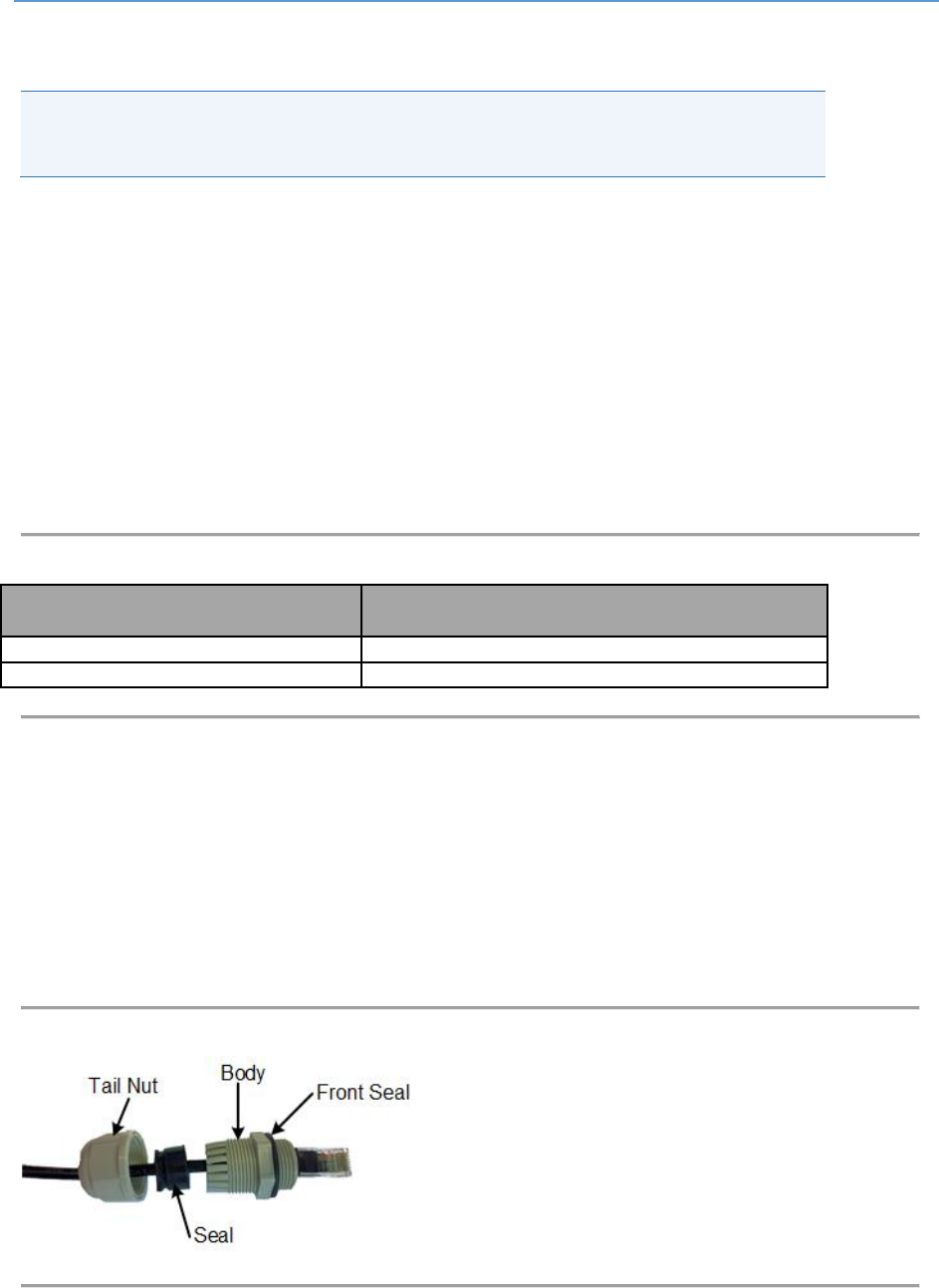
AirHarmony-1000D Installation Guide
UGD-D01083 Airspan Commercial and Internal Use 31
6 Cable Connections
Hazardous voltage! Before working, ensure that the power is removed from the power
connection cables. When the system is powered on, do not touch the power
terminals.
6.1 Copper Ethernet Cable Assembly
The following demonstrates the recommended assembly instructions, hardware and tool requirements
for the proper Ethernet cable assembly of the Ethernet Category 5e (enhanced) (CAT5e) cable used
by Airspan products.
The Ethernet cable is connected using a standard RJ45 connector protected by a harsh environment
protective casing.
6.1.1 Hardware Requirements
The following are the cable and connectors available from Airspan.
Table 13: Cable Hardware
Airspan Part Number
Description
CAT5e-STP-305M-R
CAT5e Ethernet Cable, 305M (1000ft), STP, Reel
RJ45-ETH-SHLD-CONN
RJ45 Ethernet Connector, Shielded
6.1.2 Assembly Instructions
The Copper Ethernet cable is connected to the AirHarmony-1000 using a Gland connector assembled
on the bottom panel of the unit.
1. Remove the Gland connector by unscrewing the body from the AirHarmony-1000, using
the (supplied) Gland wrench.
2. Pass the prepared Ethernet cable through the tail nut, gland seal, body and front seal of
the connector casing as shown below. Do not tighten the tail nut.
Figure 23: Ethernet Cable through connector
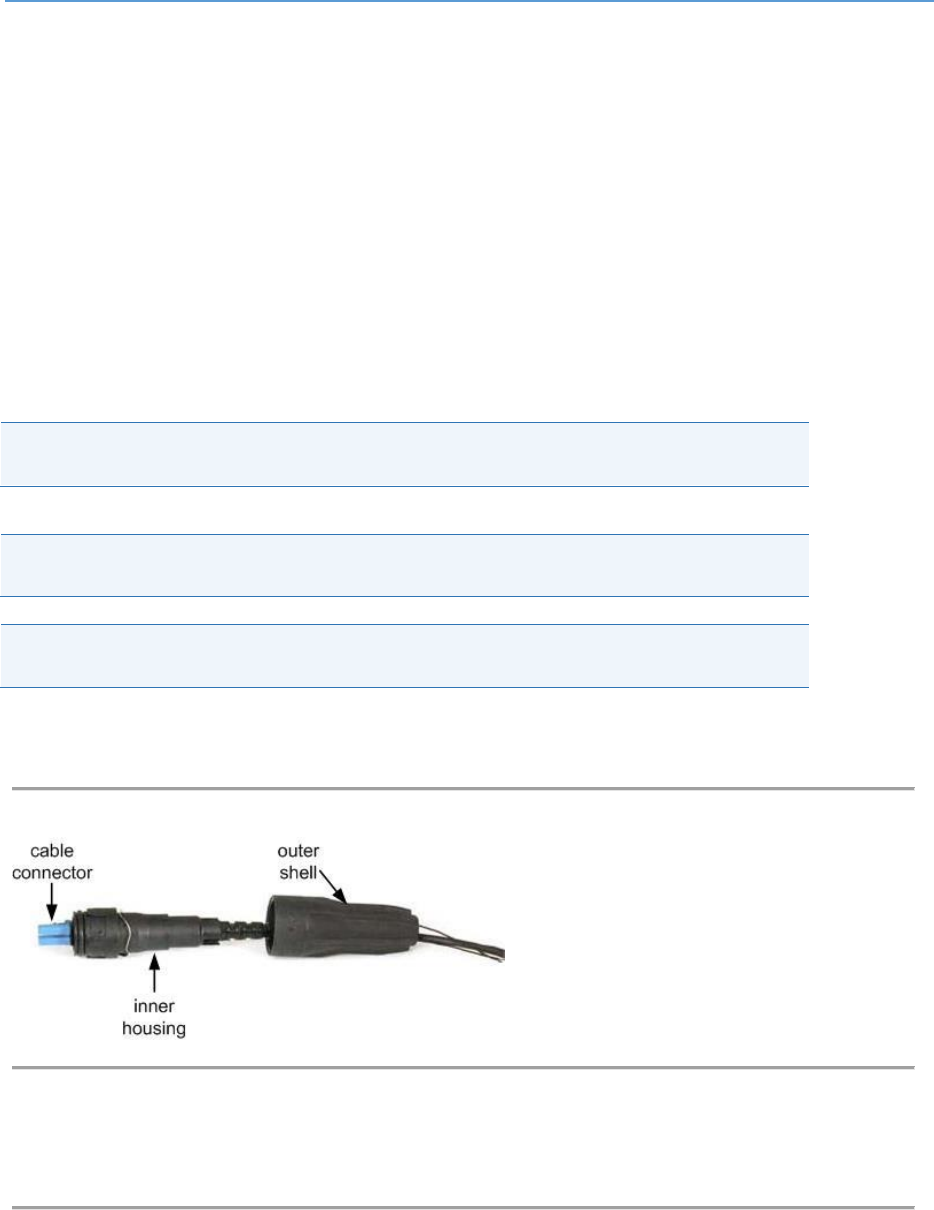
AirHarmony-1000D Installation Guide
UGD-D01083 Airspan Commercial and Internal Use 32
3. Seat the RJ45 connector plug securely into the body cavity of the AirHarmony-4000
4. Tighten the Gland body into to the threaded hole on the bottom of the AirHarmony-4000.
5. Tighten the tail nut on to the body using the included Gland wrench, forcing the seal
compress around the cable.
6. Once the connector is properly installed, the cable should be positioned and secured to
minimize stress on the cable.
6.2 Fiber Ethernet (SFP) Cable Installation
The Fiber Ethernet Small form-factor pluggable transceiver (SFP) must be connected to the
AirHarmony -1000D using an outdoor fiber cable. The optical connection enables a one-hand
installation of the connector. This enables the users to easily remove and replace the SFP transceiver
module which eliminates the need to open the unit and expose its contents to hazardous weather
conditions.
Note: Airspan recommends using the Finisar - FTLF1318P3BTL 1000BASE-LX which
has been tested and approved by Airspan. Available from Airspan if required.
The Outdoor fiber cable is available in 8 different lengths from 10m to 200m.
Note: Airspan recommends to test the fibers prior to installation (using FOA’s standard
testing industry standards).
Note: Airspan recommends to clean the fibers according to standard procedure (using
FOA’s cleaning guidance).
6.2.1 SFP Cable Connection
Figure 24: LC duplex cable assembly
1. Remove the protective dust cap from the connector housing assembled on the unit.
2. Line up the SFP transceiver module with the port and slide it into the port.
3. Connect the cable connector onto the board connector.
Figure 25: Cable connector hook up to the board connector
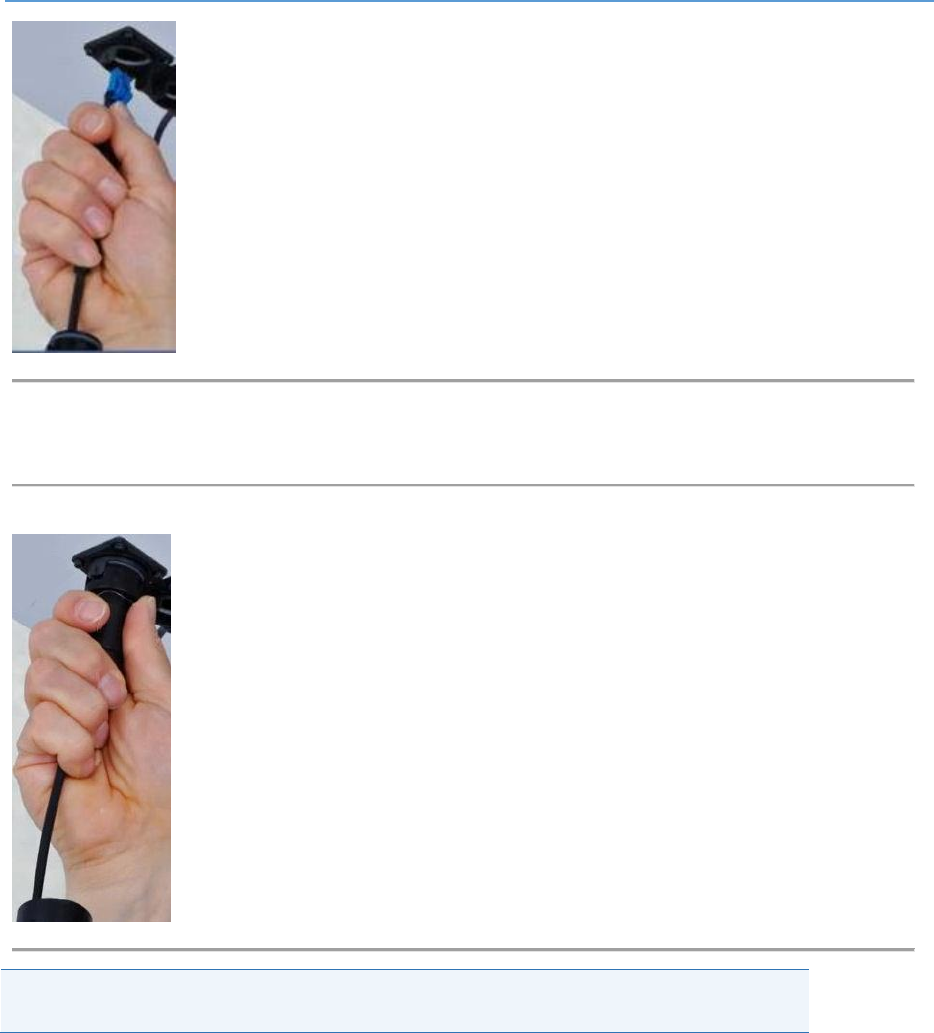
AirHarmony-1000D Installation Guide
UGD-D01083 Airspan Commercial and Internal Use 33
4. Verify that the locking latch on the cable connector is engaged on the board connector.
5. Slide the inner housing and ground shield (if present) over the cable and over the molding.
Figure 26: Slide on inner housing
Note: Check that there no space between the inner housing and mounting flange. Check
and remove any debris that might interfere with the connection.
6. Slide the outer shell over the inner housing and turn the outer bayonet shell 1/4 turn
clockwise, until it clicks into place.

AirHarmony-1000D Installation Guide
UGD-D01083 Airspan Commercial and Internal Use 34
Figure 27: Slide over and click
Note: The shell should be hand tightened only. Do NOT use tools to tighten the shell.
7. Once the connector is properly installed, the cable should be positioned and secured to
minimize stress on the cable and connector.
6.3 Power Cable Preparation
The Power cable is connected to the AirHarmony-1000D using a Gland connector assembled on the
bottom panel of the unit.
1. Remove the Gland connector by unscrewing the body from the AirHarmony-1000D, using the
Gland wrench.
2. Pass the pre-assembled connector through the tail nut, gland seal, body and rubber seal of
the connector casing as shown below. Do not tighten the tail nut.
Note The connector is attached inside the weather protected area of the enclosure and
is not subjected to water/moisture therefore the use of die-electric gels is not required.
3. Connect the DC power cable connector to the female connector outlet inside the unit.
Figure 28: Power connection on bottom panel of AirHarmony-1000D
4. Screw the gland connector plug securely into the body cavity of the unit using the provided
Gland wrench.
5. Tighten the tail nut on to the body forcing the seal to compress around the power cable using
the (provided) Gland wrench.
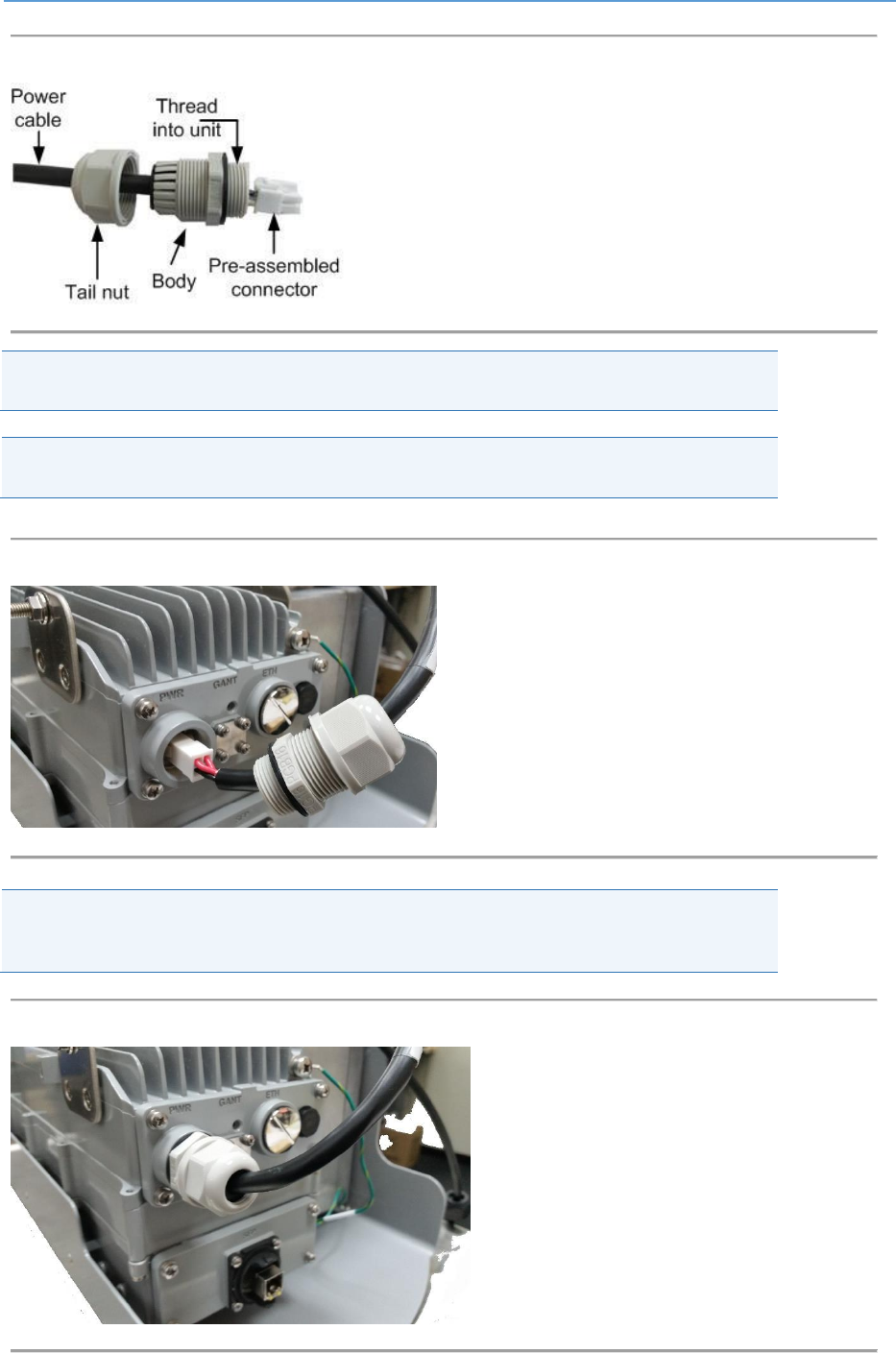
AirHarmony-1000D Installation Guide
UGD-D01083 Airspan Commercial and Internal Use 35
Figure 29: Power cable assembly
Caution: Do not over tighten the gland connector or the tail nut. The gland nut should be
tightened to a torque of no more than 3.3 Nm (2.43 lb-ft) max.
Note: When securing the cable verify there is no tension on the connector so that it is
easy to disconnect and re-connect for future maintenance actions.
Figure 30: Attach Power cable
Caution: The internal plastic parts of the mating connector are keyed. Take care to align
these by visual inspection or by gently rotating the connector body until the key way
sections align and the pins go in before tightening.
Figure 31: Power cable attached to AirHarmony-1000D
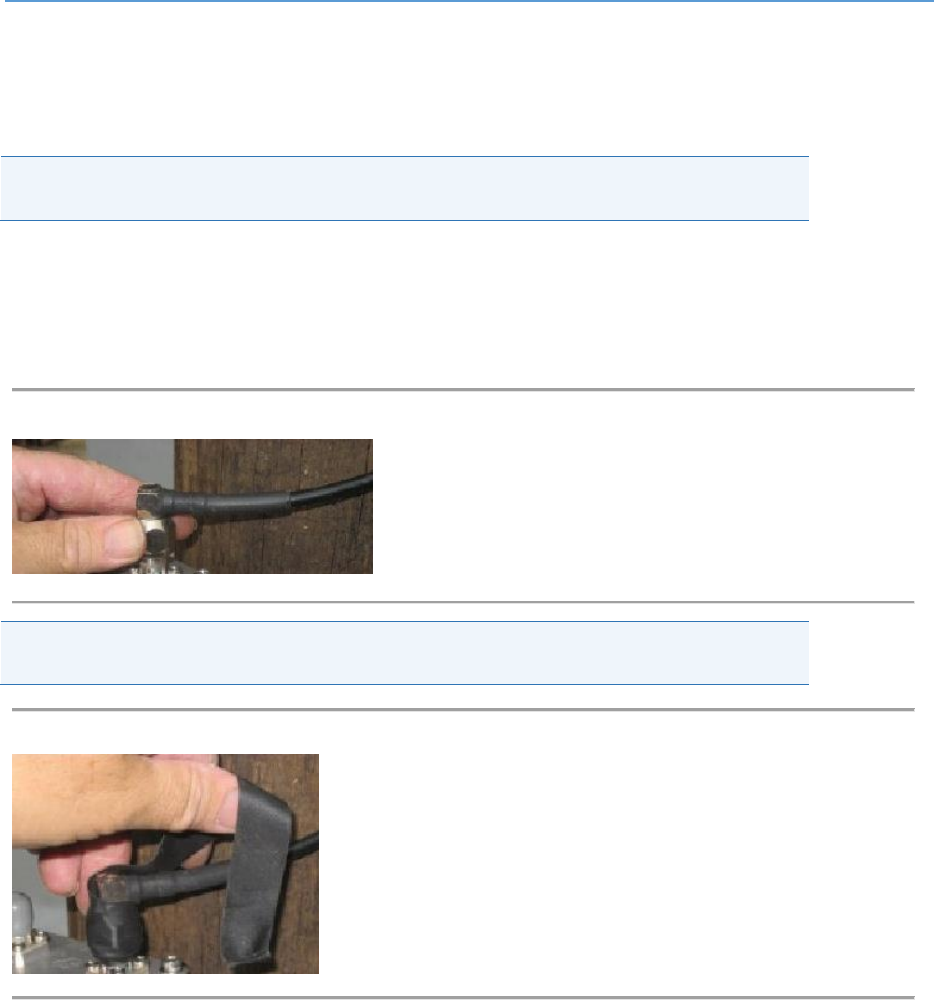
AirHarmony-1000D Installation Guide
UGD-D01083 Airspan Commercial and Internal Use 36
7 Additional Installations (Non-Standard)
7.1 Connecting RF Jumper Cables to External Antenna
Note: Variants utilizing remotely attached antennas are factory pre-assembled with a
sunshield.
For installation of a remotely mounted antenna follow the antenna manufacturer’s instructions and
connect the antenna to the AirHarmony-1000D using the appropriate cables. (Weather-proofed N-
type Heliax RF cables (ordered separately).
1. Attach, connect and secure the RF cable between the external antenna and the appropriate
RF connection on the top of the unit.
Figure 32: Connecting RF cable
Caution: Do not over-tighten the RF connector. RF failures can result when the RF
connector is over-tightened.
Figure 33: Weather-proof the connection
2. Weather-proofing of the RF N type connections is recommended. This is done with a layer of
self-amalgamating tape followed by an over layer of PVC tape.
Verify the RF connector is completely weather-sealed.

AirHarmony-1000D Installation Guide
UGD-D01083 Airspan Commercial and Internal Use 37
A Job Sheet
This job sheet enables the users to keep track of their installation. It covers all the prerequisites
required for accomplishing the AirHarmony-1000D installation.
Site Requirements
o Pole or wall for installation identified
o Position on pole or wall identified
o Pole access restrictions (highway regulations, other services on pole,
power pole)
o Method of reaching pole positions (ladders, Elevated work platform)
o AC main fuse block available for AC/DC converter (where needed)
o Configuration programming details known
o Point of connection for Ethernet (if applicable)
o All equipment items available at the installation site
o Main AirHarmony-1000D unit
o Mounting bracket and pole clamps
o AC/DC converter
o GPS Antenna
o Self-amalgamating tape
o Black PVC tape
o Weather-proofing of the connections with a layer of self-
amalgamating tape followed by an over layer of PVC tape.
o SFP cable assembly
Tool Requirements
(For further information, see Verify the Tools.)
o Large flat screw driver for pole clamps
o Small flat blade screw driver (insulated shaft recommended)
o Medium Philips head screw driver
o 13mm wrench or small pipe wrench
o 10mm wrench for unit mounting flange nuts
o Knife
o pliers
o Small side cutters
o Tweezers (or fine blade long nose pliers)
o Wire strippers
o Tilt-meter
Required Ancillary Equipment
o Laptop PC for initial configuration
o cable for temporary connection of the lap top

AirHarmony-1000D Installation Guide
UGD-D01083 Airspan Commercial and Internal Use 38
B Abbreviations
Term
Expansion
3GPP
3rd Generation Partnership Project, responsible for LTE
ABS
Almost Blank Subframe
ACS
Adjacent Channel Selectivity is a measurement of a receiver's ability
to process a desired signal while rejecting a strong signal in an
adjacent frequency channel. ACS is defined as the ratio of the receiver
filter attenuation on the assigned channel frequency to the receiver
filter attenuation on the adjacent channel frequency
AWGN
Additive White Gaussian Noise is a channel model in which the only
impairment to communication is a linear addition of white noise with a
constant spectral density and a Gaussian distribution of amplitude.
BER
Bit Error Rate
CN
Core Network
CP
Cyclic Prefix
CTC
Convolution Turbo Code is a high-performance forward error
correction (FEC) code
dB
Decibel. A logarithmic unit used to describe a ratio (such as power
ratio in radio telecommunications)
dBm
An abbreviation for the power ratio in decibels (dB) of the measured
power referenced to one milliwatt (mW). It is used as a convenient
measure of absolute power because of its capability to express both
very large and very small values in a short form
eNodeB
Evolved Node B, is the element in E-UTRAN of LTE
ESP
Encapsulating Security Payloads (ESP) provide confidentiality, data-
origin authentication, connectionless integrity, an anti-replay service (a
form of partial sequence integrity), and limited traffic-flow
confidentiality
E-UTRAN
Evolved UMTS Terrestrial Radio Access Network, is the air interface
of 3GPP's Long Term Evolution
EVM/RCE
The Error Vector Magnitude or EVM (sometimes also called Receive
Constellation Error or RCE) is a measure used to quantify the
performance of a digital radio transmitter or receiver. It is measured in
dB or percentage (%) – the lower the better
FDD
Frequency-Division Duplexing. A transceiver mode where the
transmitter and receiver operate at different carrier frequencies
GNSS
Global Navigation Satellite System is a term used to describe a
satellite navigation system with global coverage. There are currently
two fully operational GNSSs – the US GPS and the Russian
GLONASS.
GTP-U
GPRS Tunneling Protocol for User data is a relatively simple IP based
tunneling protocol which permits many tunnels between each set of
end points
HPBW
Half Power BandWidth is the angular separation in an antenna, in
which the magnitude of the radiation pattern decreases by 50% (or -3
dB) from the peak of the main beam
ICS
In-channel selectivity is a measure of the receiver’s ability to receive a
wanted signal at its assigned Resource Block locations in the
presence of an interfering signal
IPSec
Internet Protocol Security is a protocol suite for securing Internet
Protocol (IP) communications by authenticating and encrypting each
IP packet of a communication session

AirHarmony-1000D Installation Guide
UGD-D01083 Airspan Commercial and Internal Use 39
LED
Light Emitting Diode
LTE
Long Term Evolution
MAC
Medium Access Controller – responsible for several functions such
Error Correction, Packet (De)Multiplexing, etc…
MBSFN
Multicast-Broadcast Single Frequency Network is an LTE feature
designed to deliver services such as Mobile TV using the LTE
infrastructure, and is expected to be a competitor to DVB-H-based TV
broadcast
MCS
Modulation and Coding Scheme
MME
Mobility Management Entity is the key control-node for the LTE
access-network. It is responsible, among other things for idle mode
UE tracking and paging procedure including retransmissions
MTBF
Mean Time Between Failures
OFDMA
Orthogonal Frequency-Division Multiple Access (OFDMA) is a multi-
user version of OFDM digital modulation scheme, used for eNodeB
transmissions to UEs
PDCP
Packet Data Convergence Protocol. A Sub-Layer in LTE responsible
for IP Header (De)Compression, etc…
PDU
Protocol Data Unit
PTP
Precision Time Protocol is used to synchronize clocks throughout a
network. In this document, PTP is referring to IEEE1588-2008 protocol
RB
Resource Block
RLC
Radio Link Control. A Sub-Layer in LTE responsible for Ack/Nack,
error correction, packet reordering, etc…
ROHS
Restriction Of Hazardous Substances
RRM
Radio Resource Management is used to cover all functions that are
related to the assignment and sharing of radio resources among UEs
S-GW
Serving Gateway. A Core entity in the LTE EPC architecture
responsible for routing and forwarding user data packets, while also
acting as the mobility anchor for the user plane during inter-eNodeB
handovers and as the anchor for mobility between LTE and other
3GPP technologies
SBA
Switched Beam Antenna
SC-FDMA
Single-Carrier FDMA is a frequency-division multiple access scheme,
dealing with the assignment of multiple users to a shared
communication resource. Used in LTE for UE transmissions to the
eNodeB
SCTP
Stream Control Transmission Protocol is a reliable transport layer
protocol, ensuring in-sequence transport of messages with congestion
control like TCP
SDR
Software Defined Radio
WEEE
Waste Electrical and Electronic Equipment